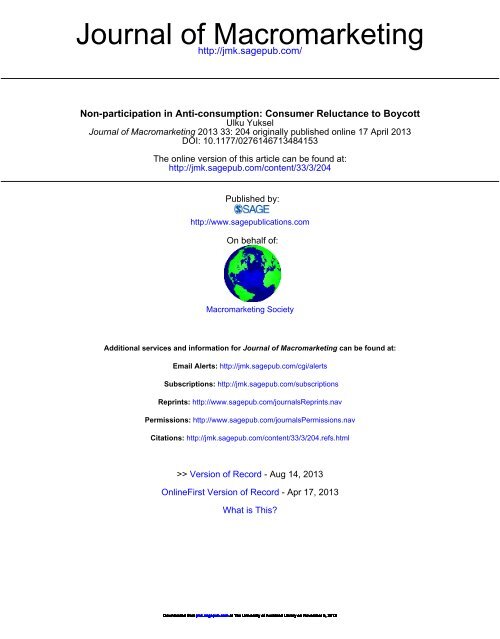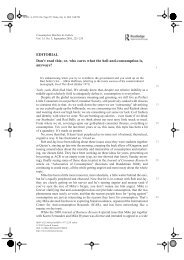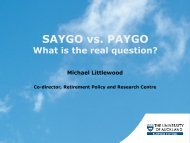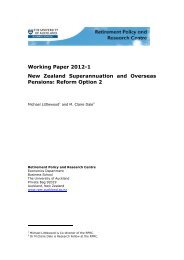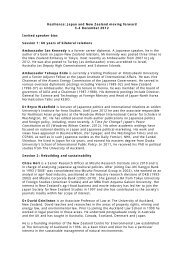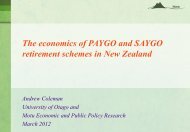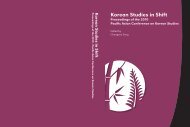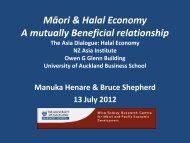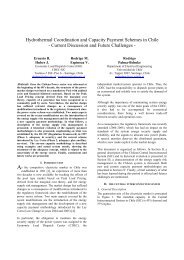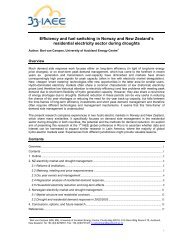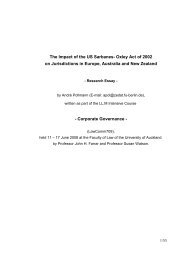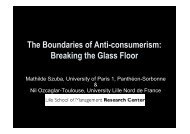Non-participation in Anti-consumption - Our publications and ...
Non-participation in Anti-consumption - Our publications and ...
Non-participation in Anti-consumption - Our publications and ...
Create successful ePaper yourself
Turn your PDF publications into a flip-book with our unique Google optimized e-Paper software.
Journal of Macromarket<strong>in</strong>ghttp://jmk.sagepub.com/<strong>Non</strong>-<strong>participation</strong> <strong>in</strong> <strong>Anti</strong>-<strong>consumption</strong>: Consumer Reluctance to BoycottUlku YukselJournal of Macromarket<strong>in</strong>g 2013 33: 204 orig<strong>in</strong>ally published onl<strong>in</strong>e 17 April 2013DOI: 10.1177/0276146713484153The onl<strong>in</strong>e version of this article can be found at:http://jmk.sagepub.com/content/33/3/204Published by:http://www.sage<strong>publications</strong>.comOn behalf of:Macromarket<strong>in</strong>g SocietyAdditional services <strong>and</strong> <strong>in</strong>formation for Journal of Macromarket<strong>in</strong>g can be found at:Email Alerts: http://jmk.sagepub.com/cgi/alertsSubscriptions: http://jmk.sagepub.com/subscriptionsRepr<strong>in</strong>ts: http://www.sagepub.com/journalsRepr<strong>in</strong>ts.navPermissions: http://www.sagepub.com/journalsPermissions.navCitations: http://jmk.sagepub.com/content/33/3/204.refs.html>> Version of Record - Aug 14, 2013Onl<strong>in</strong>eFirst Version of Record - Apr 17, 2013What is This?Downloaded from jmk.sagepub.comat The University of Auckl<strong>and</strong> Library on November 5, 2013
Article<strong>Non</strong>-<strong>participation</strong> <strong>in</strong> <strong>Anti</strong>-<strong>consumption</strong>:Consumer Reluctance to BoycottJournal of Macromarket<strong>in</strong>g33(3) 204-216ª The Author(s) 2013Repr<strong>in</strong>ts <strong>and</strong> permission:sagepub.com/journalsPermissions.navDOI: 10.1177/0276146713484153jmk.sagepub.comUlku Yuksel 1AbstractHow society affects public welfare <strong>and</strong> bus<strong>in</strong>esses via boycotts has become <strong>in</strong>creas<strong>in</strong>gly important <strong>in</strong> a connected world. Yet,research on the topic rema<strong>in</strong>s scant <strong>and</strong> focuses mostly on why consumers boycott. This study moves beyond motivations ofwhy consumers participate <strong>in</strong> boycotts, <strong>and</strong> exam<strong>in</strong>es <strong>in</strong>stead, why <strong>in</strong>dividuals are not will<strong>in</strong>g to boycott. This is important becausethe accounts for non-<strong>participation</strong> may not be the exact opposite of the reasons to participate. Informants’ reasons for notboycott<strong>in</strong>g were classified <strong>in</strong>to three broad themes: ‘‘out of sight, out of m<strong>in</strong>d,’’ ‘‘urge for freedom <strong>and</strong> self-defence,’’ <strong>and</strong> ‘‘counterarguments– scepticism or accounts.’’ The hermeneutic analysis provides a framework for underst<strong>and</strong><strong>in</strong>g boycott failures.Keywordsboycott failure, global ethical conduct, social movements, collective actions, macromarket<strong>in</strong>g.IntroductionSocieties often require their members to modify their behavior<strong>in</strong> ways that improve public well-be<strong>in</strong>g (Carman 1992). Institutionsthat have an impact on public policy use many ways toachieve the desired behavioral change <strong>in</strong> a given community,such as public behavior modification campaigns (Carman1992). It is important to underst<strong>and</strong> the way society affectscorporate behavior via consumer protests (Ettenson <strong>and</strong> Kle<strong>in</strong>2005; Olson 1965) as collective actions are becom<strong>in</strong>g an<strong>in</strong>creas<strong>in</strong>gly important phenomenon <strong>in</strong> an ever more connectedworld, especially from a macromarket<strong>in</strong>g perspective (Gao2012; Köse 2007; Witkowski 2006).Macromarket<strong>in</strong>g exam<strong>in</strong>es relationships among markets,market<strong>in</strong>g, <strong>and</strong> society. Consumer movements such as boycottsfall <strong>in</strong>to the doma<strong>in</strong> of macromarket<strong>in</strong>g (Gopaldas 2008; Lee,Fern<strong>and</strong>ez, <strong>and</strong> Hymen 2009; Witkowski 2006), partly due totheir effects on society’s well-be<strong>in</strong>g (Witkowski 1989). Studiesof (unfair) market<strong>in</strong>g practices <strong>and</strong> society’s well-be<strong>in</strong>g (Redmond2005; Shapiro, Tadajewski, <strong>and</strong> Shultz 2009) have mostlyfocused on the social consequences of conduct<strong>in</strong>g bus<strong>in</strong>ess(Nason 1989; Witkowski 2008), ethically <strong>and</strong> socially responsiblemarket<strong>in</strong>g (Ferrell <strong>and</strong> Ferrell 2008; Hill, Felice, <strong>and</strong>A<strong>in</strong>scough 2007; Laczniak <strong>and</strong> Murphy 2006), <strong>and</strong> marketorientedglobal social movements (Wilkonson 2007). This studyrelates to these themes, but takes an under-<strong>in</strong>vestigated angle tounderst<strong>and</strong> 1) the underly<strong>in</strong>g dynamics of a decision of non<strong>participation</strong><strong>in</strong> a boycott, <strong>and</strong> 2) the remedies to overcomeconsumers’ reluctance to boycott corporations conduct<strong>in</strong>g unfairbus<strong>in</strong>ess practices.To date, most boycott-specific research has focused on whyconsumers participate <strong>in</strong> boycotts, even though the reasons fornot participat<strong>in</strong>g may be no less important to underst<strong>and</strong><strong>in</strong>gsome aspects of anti-<strong>consumption</strong> <strong>and</strong> its implications for publicpolicy. Hence, the present study moves beyond the questionof why people boycott <strong>and</strong> <strong>in</strong>stead explores why some <strong>in</strong>dividualsdo not participate <strong>in</strong> boycotts. Explor<strong>in</strong>g rationales as towhy <strong>in</strong>dividuals do not participate <strong>in</strong> boycotts is importantbecause reasons for non-<strong>participation</strong> are not necessarily theexact opposite of the motivations to boycott (Chazidakis <strong>and</strong>Lee 2013).Specifically, the study explores consumer opposition to boycottrequests by boycott-organizers <strong>and</strong> how non-participantsjustify their attitudes <strong>and</strong> decisions. The research contributesto the boycott literature by draw<strong>in</strong>g on new theories to conceptualizean up-to-date boycott framework <strong>and</strong> to expla<strong>in</strong> thelikelihood of boycott failure to boycott-agents. The f<strong>in</strong>d<strong>in</strong>gselucidate why consumers may not boycott <strong>and</strong> how theyaccount for this decision. To the best of the author’s knowledge,only one published study has referred to motivations notto boycott (Kle<strong>in</strong>, Smith, <strong>and</strong> John 2004). However, that studyfocused on why people boycott <strong>and</strong> their motivations for do<strong>in</strong>gso <strong>and</strong> then implied that people without these reasons might bemore likely to not participate <strong>in</strong> boycotts. Yet, the motives fornot boycott<strong>in</strong>g may not be the direct opposite of those for1 The University of Sydney Bus<strong>in</strong>ess School, Sydney, AustraliaCorrespond<strong>in</strong>g Author:Ulku Yuksel, The University of Sydney Bus<strong>in</strong>ess School, Economics <strong>and</strong> Bus<strong>in</strong>essBuild<strong>in</strong>g, H69, Cnr. Codr<strong>in</strong>gton & Rose streets, Level 5, Room 513,Sydney, NSW 2006 Australia.Email: ulku.yuksel@sydney.edu.au
Yuksel 205boycott<strong>in</strong>g (Chazidakis <strong>and</strong> Lee 2013). Therefore, the presentstudy focuses directly on why people do not boycott <strong>and</strong> theirmotivations beh<strong>in</strong>d this decision, some of which may be consideredas accounts for non-<strong>participation</strong>. This study extendsprevious research on boycotts by provid<strong>in</strong>g new theoretical frameworks(e.g., distance, reactance, persuasion knowledge, <strong>and</strong>accounts) for why consumers may choose not to participate <strong>in</strong> aboycott.The rema<strong>in</strong>der of the article is organized as follows. First,def<strong>in</strong>itions <strong>and</strong> conceptualizations of boycotts are provided.Then the exploratory <strong>and</strong> descriptive nature of the methodologyis expla<strong>in</strong>ed. Next, detailed f<strong>in</strong>d<strong>in</strong>gs <strong>and</strong> samples of verbatimtranscripts are presented, followed by <strong>in</strong>terpretations ofseveral themes emerged from <strong>in</strong>formants’ decisions on notparticipat<strong>in</strong>g <strong>in</strong> boycotts. F<strong>in</strong>ally, a discussion <strong>and</strong> conclusionsection presents the theoretical <strong>and</strong> contextual implications ofthe current f<strong>in</strong>d<strong>in</strong>gs, limitations, <strong>and</strong> suggestions for furtherresearch for scholars <strong>in</strong> consumer behavior, social market<strong>in</strong>g,<strong>and</strong> macromarket<strong>in</strong>g.What Are Boycotts?Boycotts have existed for many years as a means for consumersto express their disapproval of a company’s products or corporatebehavior (Zack 1991) <strong>and</strong> to punish bus<strong>in</strong>esses for unfavorablebehavior (Neilson 2010). Boycotts are def<strong>in</strong>ed astemporary acts of exit<strong>in</strong>g a relationship with an organizationow<strong>in</strong>g to some form of dissatisfaction, accompanied by a promiseto re-enter the relationship once certa<strong>in</strong> conditions havebeen met, such as a change <strong>in</strong> policy by the offend<strong>in</strong>g party(Hirschman 1970). As such, boycotts are actions that refer tostopp<strong>in</strong>g, modify<strong>in</strong>g, or forego<strong>in</strong>g <strong>consumption</strong>, <strong>in</strong> which peoplerefuse to purchase <strong>and</strong>/or use a br<strong>and</strong> that they had beenus<strong>in</strong>g, <strong>and</strong>, were it not for the circumstances precipitat<strong>in</strong>g theboycott, would cont<strong>in</strong>ue to use.Boycotts are typically triggered by an environmental, social,ethical, or political rationale (Dolan 2002; Yuksel <strong>and</strong> Myrteza2009; Zack 1991) <strong>and</strong> relate to choices that often reflect a concernfor the ‘‘general good’’ (Shaw 2007). Thus, boycotts aresociety’s collective reactions (Shapiro, Tadajewski, <strong>and</strong> Shultz2009) to corporate practices that are perceived as unfair orunethical. This conceptualization opens an important venue<strong>in</strong> which to focus on the relationship between macromarket<strong>in</strong>g<strong>and</strong> consumer boycotts, because, when effective, the marketworks as a pull factor for secur<strong>in</strong>g a communal issue (i.e.,human rights; Micheletti <strong>and</strong> Stolle 2007). ‘‘Political consumerism’’will happen <strong>in</strong> the form of a boycott when consumersbe<strong>in</strong>g asked to boycott <strong>in</strong>tentionally use their aim to modifyobjectionable practices <strong>in</strong> the marketplace as basis for (not)purchas<strong>in</strong>g (Micheletti <strong>and</strong> Stolle 2007).Collective actions (Miller <strong>and</strong> Sturdivant 1977) <strong>and</strong> socialmovements are planned, collective attempts to engender atransformation (Buechler 2000; Gabriel <strong>and</strong> Lang 1995), oftentimesaround <strong>consumption</strong> <strong>and</strong> market<strong>in</strong>g (Koz<strong>in</strong>ets <strong>and</strong>H<strong>and</strong>elman 2004). Boycotts are a form of social movementssuch as protest movements or political demonstrations (Koku2011). As a social phenomenon, boycotts necessitate a substantially‘‘concerted group effort’’ (Koku 2011, p. 84) <strong>in</strong> order toprove successful. Although social boycotts serve as an <strong>in</strong>tendedgroup-tool used with the aim of mobiliz<strong>in</strong>g people <strong>in</strong> a society,unlike most strikes, for example, they have no enforced <strong>participation</strong>obligation. Yet, ample <strong>participation</strong> is fundamental tothe success of a boycott action. Study<strong>in</strong>g <strong>in</strong>dividual motivationsto boycotts is pivotal because the juxtaposition of <strong>in</strong>dividualdecision-mak<strong>in</strong>g sets off the communal success of suchsocial movements.As <strong>in</strong> boycotts, the goal of consumer movements is tochange the pr<strong>in</strong>ciples or practices of targeted bus<strong>in</strong>esses or governments,<strong>and</strong> persuade as many <strong>in</strong>dividuals as possible to rebel(Friedman 1999a; Rao 1998; Witkowski 1989). As such,today’s activists tend to turn to the worldwide web as a wayto <strong>in</strong>form the masses easily <strong>and</strong> cheaply (Ward <strong>and</strong> Ostrom2006). Once <strong>in</strong>itiated, a boycott ‘‘<strong>in</strong> one city may mobilize<strong>in</strong>terest <strong>in</strong> other cities <strong>and</strong> lead to diffusion of consumer leagues<strong>in</strong> a social movement-like process’’ (Rao, Morrill, <strong>and</strong> Zald2000, p. 244). Thus, consumer boycotts are <strong>in</strong>herently collectiveactions <strong>and</strong> social movements (John <strong>and</strong> Kle<strong>in</strong> 2003), aswell as social dilemmas (Sen, Gurhan-Canli, <strong>and</strong> Morwitz2001). Members of social groups face a trade-off between maximiz<strong>in</strong>gtheir own immediate utility <strong>and</strong> sacrific<strong>in</strong>g their shorttermutility <strong>in</strong> the hope of collectively achiev<strong>in</strong>g a goal (Yuksel<strong>and</strong> Myrteza 2009) that will maximize the long-term utility ofthe society, if achieved.Boycott behavior can be split <strong>in</strong>to two basic types accord<strong>in</strong>gto the expectations of the boycotters participat<strong>in</strong>g: <strong>in</strong>strumental(i.e., <strong>in</strong>fluential <strong>and</strong> active) <strong>and</strong> non-<strong>in</strong>strumental (i.e., expressive<strong>and</strong> punitive) (Smith 1990). Instrumental boycotts representtactics to <strong>in</strong>fluence <strong>and</strong> improve the unfavorablebehavior of corporations <strong>and</strong> aim to change their actions.<strong>Non</strong>-<strong>in</strong>strumental boycotts, on the other h<strong>and</strong>, serve as expressionsof emotions (S<strong>and</strong>l<strong>in</strong> <strong>and</strong> Callahan 2009), such as angeror outrage at the acts of the marketer without any expectationsof improvement (Micheletti 2007). In general, ethically concernedconsumers view multi-national companies as adversaries(Koz<strong>in</strong>ets <strong>and</strong> H<strong>and</strong>elman 1998) <strong>and</strong> express theirconcerns by boycott<strong>in</strong>g. In this sense, their purchases can beviewed as ‘‘votes’’ <strong>in</strong> the marketplace (Schwarzkopf 2011;Shaw 2007). At times, consumers also view other consumersas adversaries (Koz<strong>in</strong>ets <strong>and</strong> H<strong>and</strong>elman 1998). These considerationsmay shed light on the social dynamics of failed consumeractivism.Other dynamics that underlie a boycott non<strong>participation</strong>decision <strong>in</strong>clude: 1) the perceived egregiousness of the unethicalaction; 2) the cost of constra<strong>in</strong>ed <strong>consumption</strong> relat<strong>in</strong>g tothe volume <strong>and</strong> importance of <strong>consumption</strong> to the boycotter;3) perceived unlikelihood of success engendered by anticipatedboycott <strong>participation</strong> by others – i.e. low expectations of overall<strong>participation</strong> generat<strong>in</strong>g a sense of <strong>in</strong>effectiveness (John <strong>and</strong>Kle<strong>in</strong> 2003); 4) credibility of the boycott call or the organizer(Sen, Gurhan-Canli, <strong>and</strong> Morwitz 2001); <strong>and</strong> f<strong>in</strong>ally, 5) counterargumentsthat <strong>in</strong>hibit boycott<strong>in</strong>g. Counterarguments<strong>in</strong>clude perceived personal <strong>in</strong>capability (efficacy), address<strong>in</strong>g
206 Journal of Macromarket<strong>in</strong>g 33(3)Table 1. Profile of Informants.# Informant Gender Age OccupationSelf-confessedcommitmentto the br<strong>and</strong>1 Donald M 21 Student No No2 Sarah F 24 Student Yes No3 Jill F 45 Academic Yes No4 Elizabeth F 46 Housewife No No5 Richard M 29 Architect Yes No6 James M 41 Builder Yes No7 Jack M 43 Salesperson No No8 Paul M 48 Shop NoNoowner9 Chris M 41 Academic Yes No10 Chong F 26 Student No NoSelf-confessedcommitmentto compet<strong>in</strong>gbr<strong>and</strong>‘‘small agent,’’ ‘‘free-rider,’’ <strong>and</strong> ‘‘social loaf<strong>in</strong>g’’ issues (Blais2001; Latane, Williams, <strong>and</strong> Hark<strong>in</strong>s 1979; Weimann 1994),especially when there is little or no motivation for a groupmember to participate (John <strong>and</strong> Kle<strong>in</strong> 2003). Consumers mayuse some of these counterarguments as an excuse (Eckhardt,Belk, <strong>and</strong> Dev<strong>in</strong>ney 2010) or justification strategy (Ger <strong>and</strong>Belk 1999) to rationalize a non-<strong>participation</strong> decision perceivedas improper.Social contract theory (Hampton 1980) <strong>in</strong>forms people, whocome together through a mutual consent to form a society,agree to abide by implicit norms. Accord<strong>in</strong>gly, boycott participantsrepresent members of a society be<strong>in</strong>g attacked <strong>and</strong>, thus,would feel enforced to pull together to secure the communal<strong>in</strong>terest. Yet, society’s collective <strong>in</strong>terest <strong>and</strong> <strong>in</strong>dividual self<strong>in</strong>terestmay conflict. As such, personal bases for any utilityga<strong>in</strong> or loss from boycott <strong>participation</strong> (Friedman 1991,1999a) may play a role <strong>in</strong> decision-mak<strong>in</strong>g.Previous literature on collective actions has associatedboycott<strong>in</strong>g with pro-social behavior <strong>and</strong> altruism (Paek <strong>and</strong> Nelson2009). People may boycott a firm simply if they believe itharms other people, for example, to protest dangerous work<strong>in</strong>gconditions <strong>in</strong> a factory (John <strong>and</strong> Kle<strong>in</strong> 2003). This is the basisof the boycott call case used <strong>in</strong> this study. Through boycott<strong>in</strong>g,people extend altruistic sentiments to others (Neilson 2010) tofacilitate a utilitarian social welfare function, whilst feel<strong>in</strong>g goodabout themselves. In this case, the decision falls <strong>in</strong>to the scope ofenhanc<strong>in</strong>g self-esteem (Fe<strong>in</strong> <strong>and</strong> Spencer 1997) that relates to adesire to make a difference. For people who endorse empathy,boycott<strong>in</strong>g reflects a concern for the ‘‘general good’’ <strong>and</strong> mayserve as a means of enhanc<strong>in</strong>g self-concept.In social contract groups, which constitute a given society,pursu<strong>in</strong>g a boycott call request of the group verifies that theparticipant obeys the group norms <strong>and</strong> cares about others <strong>in</strong>do<strong>in</strong>g the right th<strong>in</strong>g (John <strong>and</strong> Kle<strong>in</strong> 2003). Group memberswould experience the social dynamics of be<strong>in</strong>g swept up <strong>in</strong> thespirit of group action <strong>in</strong> which act<strong>in</strong>g with<strong>in</strong> the group norm isthe required behavior. Consequently, participat<strong>in</strong>g <strong>in</strong> a boycottmay facilitate enhanced feel<strong>in</strong>gs of good conscience or moralsuperiority.People may decide to boycott as an approach strategy whensuch expressive motivation is driven by positive associations<strong>and</strong> <strong>in</strong>creased positive self-view, termed a ‘‘clean h<strong>and</strong>s’’ motivation(Smith 1990). At times, members of societies obey thegroup’s expectations as an avoidance strategy from negativeself-perceptions: guilt or cognitive dissonance (Kle<strong>in</strong>, Smith,<strong>and</strong> John 2004) engendered by (not) boycott<strong>in</strong>g (Fest<strong>in</strong>ger1957) <strong>and</strong> protest<strong>in</strong>g (Lemire 2002; Sussman 2000). Boycottsas an avoidance strategy serve to limit or cease negative associations.Such an avoidance motivation represents the conceptualopposite of clean h<strong>and</strong>s motivation, called ‘‘dirty h<strong>and</strong>s’’(John <strong>and</strong> Kle<strong>in</strong> 2003). Both types of motivation enhance one’ssense of align<strong>in</strong>g with the group norm, <strong>and</strong> self esteem <strong>and</strong> helpavoid the dissonance (Kle<strong>in</strong>, Smith, <strong>and</strong> John 2004) that wouldbe generated by not participat<strong>in</strong>g.The StudyThe responses of <strong>in</strong>dividuals to a real-world boycott of Coca-Cola (see http://killercoke.org/) were analyzed. The boycottcampaign, detailed <strong>in</strong> the procedure, relates to Coke’s misconducts<strong>in</strong> Columbia <strong>and</strong> is still ongo<strong>in</strong>g. The exploratory study isbased on qualitative data obta<strong>in</strong>ed from <strong>in</strong>terviews (Kvale1983) to obta<strong>in</strong> a ‘‘first-person description’’ (Thompson,Loc<strong>and</strong>er, <strong>and</strong> Pollio 1989, p. 138) that emphasized the‘‘doma<strong>in</strong>-specific’’ perceptions of participants <strong>in</strong> an <strong>in</strong>dustrializedcity <strong>in</strong> Australia. Given that the success of a boycottdepends on the juxtaposition of each <strong>in</strong>dividual’s decision, the<strong>in</strong>itial underst<strong>and</strong><strong>in</strong>g of the phenomenon at an <strong>in</strong>dividual levelis essential. Informants were identified through a network ofcolleagues, friends, <strong>and</strong> students; deliberately chosen to offera cross-section of a Coke-dr<strong>in</strong>k<strong>in</strong>g society. After review<strong>in</strong>g thetranscribed texts of 10 <strong>in</strong>terviews, a strong pattern of repetition<strong>and</strong> recycl<strong>in</strong>g of ideas was observed, suggest<strong>in</strong>g that saturationwas reached <strong>and</strong> no new <strong>in</strong>formation would be revealed <strong>in</strong> further<strong>in</strong>terviews (Belk 1992, 2008; Denz<strong>in</strong> <strong>and</strong> L<strong>in</strong>coln 2005;McCracken 1988; Strauss <strong>and</strong> Corb<strong>in</strong> 1998; Thompson 1996).The <strong>in</strong>terviews took place either at the homes of the <strong>in</strong>formantsor at the work place of the <strong>in</strong>terviewer (i.e., universitycampus). The ma<strong>in</strong> criterion for the selection of <strong>in</strong>formants foran <strong>in</strong>-depth <strong>in</strong>terview was the <strong>in</strong>formant’s declaration of ‘‘notbe<strong>in</strong>g will<strong>in</strong>g to participate’’ <strong>in</strong> the boycott, after they weremade aware of it, discussed <strong>in</strong> the procedure. This precaution,as a way to establish a boundary condition, was the central prerequisitefor the study’s scope (see Table 1). This is because theaim of the study was not a comparison of boycotters versusnon-boycotters, as many previous studies have already <strong>in</strong>vestigatedboycotters’ motivations (e.g., see Kle<strong>in</strong>, Smith, <strong>and</strong> John2004). Second, all <strong>in</strong>formants had declared that they hadbought <strong>and</strong> consumed at least two serv<strong>in</strong>gs (cans or bottles)of Coke with<strong>in</strong> the two weeks preced<strong>in</strong>g the <strong>in</strong>terview date.The amount of product consumed was considered to be a moreobjective selection criterion to generate a detrimental cost tothe <strong>in</strong>formants, rather than subjective, self-confessed br<strong>and</strong>loyalty, given actual boycott calls are directed to all consumersregardless of their loyalty levels. Third, none of the selected
Yuksel 207<strong>in</strong>formants had a previous theoretical underst<strong>and</strong><strong>in</strong>g of boycott<strong>in</strong>gpractices. F<strong>in</strong>ally, all <strong>in</strong>formants had <strong>in</strong>dicated that theywere will<strong>in</strong>g to share their personal views with the <strong>in</strong>terviewer(Thompson, Loc<strong>and</strong>er, <strong>and</strong> Pollio 1989).The purpose of the <strong>in</strong>terviews was to acquire descriptivedetails of <strong>in</strong>formants’ perceptions of a phenomenon <strong>in</strong>volv<strong>in</strong>ga boycott request for a very well-known br<strong>and</strong> with a strongbr<strong>and</strong> image, as detailed <strong>in</strong> the procedure. Previous literaturehas emphasized the benefits of <strong>in</strong>tegrat<strong>in</strong>g prior knowledge <strong>and</strong>experience <strong>in</strong>to the design (Arora <strong>and</strong> Huber 2001) <strong>and</strong> context(Allenby, Arora, <strong>and</strong> G<strong>in</strong>ter 1995) of a study. Hence, for thetested boycott decision to be genu<strong>in</strong>e <strong>and</strong> realistic, Coke waschosen (see also Ger <strong>and</strong> Belk 1996). In addition, anti-Cokemovements have been the focus of previous research (Varman<strong>and</strong> Belk 2009). It is a real br<strong>and</strong> that nearly everyone willdr<strong>in</strong>k at one time or another <strong>in</strong> his or her lifetime (Yuksel <strong>and</strong>Myrteza 2009).Focus on an <strong>in</strong>ternational boycott served the follow<strong>in</strong>g purposes.First, with the ever-<strong>in</strong>creas<strong>in</strong>g use of onl<strong>in</strong>e technology,<strong>in</strong>ternational boycotts are now much easier to successfully<strong>in</strong>itiate <strong>and</strong> ma<strong>in</strong>ta<strong>in</strong> (Sen, Gurhan-Canli, <strong>and</strong> Morwitz 2001).Second, large-scale national <strong>and</strong> <strong>in</strong>ternational boycotts are farmore common than local ones <strong>and</strong> receive widespread mediacoverage (Friedman 1999b). Third, they require long-termcommitments by the boycotters as they may extend for anextended period of time compared to a local boycott that isnormally considered a one-time affair designed to correct a s<strong>in</strong>glewrong. Fourth, they predom<strong>in</strong>antly <strong>in</strong>volve well-knownbus<strong>in</strong>esses or br<strong>and</strong> names, which makes it easier for the potentialboycotters to relate to the product <strong>in</strong> question (Ferguson1997). F<strong>in</strong>ally, local boycotts are mostly narrow <strong>and</strong> restricted<strong>in</strong> their scope, effect, <strong>and</strong> amount of participants required. Mostorganized boycotts today are focused on permanently modify<strong>in</strong>gbuy<strong>in</strong>g habits, often as part of a larger political program thatentails an extended obligation, such as the recent <strong>in</strong>ternational‘‘Boycott Apple’’ call (2012) to protest the Foxconn humanright issues occurr<strong>in</strong>g <strong>in</strong> Ch<strong>in</strong>a.Interviews started with questions target<strong>in</strong>g <strong>in</strong>formants’ purchase<strong>and</strong> <strong>consumption</strong> of Coke <strong>and</strong> general questions abouttheir knowledge <strong>and</strong> perceptions of boycotts (McCracken1988). Then <strong>in</strong>formants were presented with an article (<strong>and</strong>web-l<strong>in</strong>k) that calls for boycott<strong>in</strong>g Coke due to labor-relatedmisconducts <strong>in</strong> South America. As most <strong>in</strong>ternational boycottcalls orig<strong>in</strong>ate elsewhere <strong>in</strong> the world, this wide-spread BoycottCoke call was employed. The article outl<strong>in</strong>ed the specifieddoma<strong>in</strong> (Thompson, Loc<strong>and</strong>er, <strong>and</strong> Pollio 1989) of the context<strong>and</strong> described a real event (http://killercoke.org/), similar tomany others that can be found on numerous websites. The articlewas about Coke <strong>and</strong> human rights <strong>and</strong> expla<strong>in</strong>ed <strong>in</strong> detailhow ‘‘union workers <strong>in</strong> Columbia who bottle Coke productsare kidnapped, tortured, <strong>and</strong> murdered’’ <strong>and</strong> accused the‘‘Coca-Cola Company’’ of ‘‘look<strong>in</strong>g the other way as plantmanagers encourage paramilitaries to destroy unions.’’ At theend of the article, the <strong>in</strong>formants read the follow<strong>in</strong>g request:‘‘The Local Committee Aga<strong>in</strong>st Coke asks you to BoycottCoke.’’ F<strong>in</strong>ally, <strong>in</strong>formants were asked whether they wouldcomply with the call to boycott Coke <strong>and</strong> then to describe theirthoughts regard<strong>in</strong>g the boycott request.Throughout the data-gather<strong>in</strong>g process, tape-recorded <strong>in</strong>terviewswere transcribed <strong>and</strong> reviewed systematically to facilitatethe focus of subsequent <strong>in</strong>terviews (Schouten 1991). Interviewdata were analyzed for common themes across <strong>in</strong>formants forfurther categorization, based on the assumption that somethemes of conceptions of boycott behavior may emerge from theperceptions of non-participants (Thompson 1997). Then, thetranscripts were read multiple times to identify the most significant<strong>and</strong> frequent themes for classification (Giorgi 1997). Hermeneuticanalysis was conducted by a close read<strong>in</strong>g of verbatimtranscripts (Dilthey 1977) <strong>and</strong> the iterative <strong>in</strong>terpretation process(Thompson 1996). Read<strong>in</strong>g transcripts multiple times helped todevelop a holistic underst<strong>and</strong><strong>in</strong>g of <strong>in</strong>formant narratives, whichwas further enhanced by more read<strong>in</strong>g, document<strong>in</strong>g, <strong>and</strong> systematiz<strong>in</strong>g.Key phrases <strong>and</strong> patterns of mean<strong>in</strong>g were noted forfurther analysis. Follow<strong>in</strong>g this, the author developed thematiccategories <strong>and</strong> identified holistic relationships among the mean<strong>in</strong>gs<strong>and</strong> categories that the <strong>in</strong>formants used to describe theirviews <strong>and</strong> non-<strong>participation</strong> decision.F<strong>in</strong>d<strong>in</strong>gsOut of Sight, Out of M<strong>in</strong>dI personally th<strong>in</strong>k that the problem is too far away to worry about,<strong>and</strong> what the committee is do<strong>in</strong>g is too far-fetched. Sure, boycott<strong>in</strong>gmay disrupt earn<strong>in</strong>gs for Coke to some extent ...but it wouldnot make a big deal for the company. What can we do ... here <strong>in</strong>Sydney ... when they are there? ... It had to be organized overthere ... I believe that the organizers of the event are pursu<strong>in</strong>g theirown personal targets rather than help<strong>in</strong>g the Columbian workers.... I th<strong>in</strong>k my boycott<strong>in</strong>g Coke will not help the workers at all(Donald).The preced<strong>in</strong>g excerpt reflects Donald’s thoughts about boycott<strong>in</strong>gCoke. He perceives the committee’s request as unrealistic(‘‘far-fetched’’) <strong>and</strong> embellished because the problemoccurs somewhere ‘‘faraway’’ (What can we do ...here <strong>in</strong>Sydney ...when they are there?). His response appears to representdetachment <strong>and</strong> irrelevance with regard to his perceptionof the location, nature, <strong>and</strong> cause of the boycott call. Distancereduces the gravity of a communication (Sen, Gurhan-Canli,<strong>and</strong> Morwitz 2001). This is because, if a request is perceivedas not be<strong>in</strong>g directly related to a person called for boycott, attributableto perceived distance with regard to location (physical)<strong>and</strong>/or culture (social), then the content may not be soundenough to encourage that person to boycott. Research on <strong>consumption</strong>policies echoes that ‘‘the temporal <strong>and</strong> spatialdistance from any potentially harmful effects makes causebasedattribution difficult’’ (Reisch 2004, p. 32). Yet, the <strong>in</strong>formantmay possibly have used perceived distance as an excuseto justify a decision that did not feel right, with or without<strong>in</strong>tent (Eckhardt, Belk, <strong>and</strong> Dev<strong>in</strong>ney 2010).
208 Journal of Macromarket<strong>in</strong>g 33(3)The tone of Donald’s comments also <strong>in</strong>dicates mistrust towardthe source as he questions whether organizers would have adifferent agenda than assist<strong>in</strong>g workers ( ...organizers ...arepursu<strong>in</strong>g their own personal targets rather than help<strong>in</strong>gthe ...workers). Given the legitimacy of the <strong>in</strong>ternational boycottcall was verified by widespread evidence (media coverage <strong>and</strong>articles on this specific call), his account for not jo<strong>in</strong><strong>in</strong>g the proteston the grounds of mistrust h<strong>in</strong>ts at an excuse. People may feelobliged to offer explanations for questionable behavior, consciouslyor unconsciously (Ger <strong>and</strong> Belk 1999), to lessencondemnation.Also, if the content of the cause seems unrelated to an <strong>in</strong>dividual(e.g., ‘‘an organizational issue’’ [Chris], ‘‘whole issue isrelated to the corporation’’ [Elizabeth]), people may feel noneed to participate <strong>in</strong> a boycott. Ger <strong>and</strong> Belk (1999) conceptualizesuch justifications as accounts for behaviors <strong>in</strong>consistentwith beliefs. Chris professed to care about the issue butjustified his decision by transmitt<strong>in</strong>g the responsibility toanother <strong>in</strong>stitution. He says he shouldn’t be held liable becausethe case is the responsibility of the organization. Eckhardt,Belk, <strong>and</strong> Dev<strong>in</strong>ney (2010) classify such rationalizations toexpla<strong>in</strong> <strong>in</strong>consistencies as ‘‘<strong>in</strong>stitutional dependency’’ (p. 431).Indeed, <strong>in</strong> the present study, non-participants emphasizedthat the human rights violations were happen<strong>in</strong>g too ‘‘faraway’’ (<strong>in</strong> Columbia) as a pretext of their non-<strong>participation</strong>decision. Hence, the physical distance of the issue at h<strong>and</strong> madethe request for a boycott, from their po<strong>in</strong>t of view, irrelevant.The unfavorable <strong>in</strong>cidents seemed ‘‘too far away to worryabout;’’ thus, the call for boycott appeared to be ‘‘too farfetched’’(Donald) <strong>and</strong> generated a sense of detachmentbecause ‘‘those human rights violations are happen<strong>in</strong>g far awayfrom our [their] country’’ (Chong) <strong>and</strong> ‘‘it only happens <strong>in</strong>Columbia’’ <strong>and</strong>, therefore, ‘‘is clearly [related] with peoplerunn<strong>in</strong>g the Columbian plant’’ (Paul).Moreover, to some, the problem seems to be too small <strong>in</strong> thebig picture, as ‘‘Columbia is just one of the Coke manufactur<strong>in</strong>gareas’’ (James), <strong>in</strong>dicat<strong>in</strong>g another form of detachment <strong>and</strong>irrelevance for two reasons. First, Coke is perceived as a companythat is ‘‘too large’’ (Sarah) <strong>and</strong> the ‘‘<strong>in</strong>cidents <strong>in</strong> oneplant’’ (Chris) only are too m<strong>in</strong>or to bother with <strong>and</strong> Coke is toobig to change. James, along with others, perceived the <strong>in</strong>cidents<strong>in</strong> one plant to be too small to worry about, <strong>and</strong> considered himselftoo small <strong>in</strong> the system to make a change. As supported <strong>in</strong>the boycott literature, awareness of a small agent problem <strong>in</strong>boycott behavior (Kle<strong>in</strong>, Smith, <strong>and</strong> John 2004) reduces theperceived efficacy of boycott<strong>in</strong>g (Sen, Gurhan-Canli, <strong>and</strong> Morwitz2001), thus, reduc<strong>in</strong>g boycott <strong>participation</strong>.Additionally, the <strong>in</strong>cident itself was ‘‘not related to the productquality.’’ Therefore, ‘‘noth<strong>in</strong>g is wrong with dr<strong>in</strong>k<strong>in</strong>gCoke’’ as it is a ‘‘managerial problem’’ <strong>and</strong> has ‘‘really noth<strong>in</strong>gto do with dr<strong>in</strong>k<strong>in</strong>g Coke’’ (Jack). Jack is attribut<strong>in</strong>g the workers’problems to the management. External attribution occurswhen people (e.g., Jack) attribute causes to situational factors(We<strong>in</strong>er 1986), perhaps to avoid a challenge (of boycott<strong>in</strong>g).The motivational aspect of people mak<strong>in</strong>g sense of events isbased on their motives to f<strong>in</strong>d a cause <strong>and</strong> their knowledge ofthe situation. As a result, people may associate events withsome predicted or self-assigned causes or concerns (‘‘managerial’’)that are not necessarily correct. Attribution errors happenwhen consumers evaluate or attempt to employ rationales forsome actions (Heider 1958), such as when purchas<strong>in</strong>g unethicalproducts or mak<strong>in</strong>g br<strong>and</strong> attributions to decisions (Valor2008). When mak<strong>in</strong>g attributions, people may go beyond the<strong>in</strong>formation given <strong>and</strong> make <strong>in</strong>ferences about themselves <strong>and</strong>others, as well as about the surround<strong>in</strong>gs of the event. The secondconsideration <strong>in</strong>formants displayed (i.e., irrelevance tooneself) proves that they did attribute the cause to an externalfactor, did not feel direct empathy for the union workers <strong>in</strong>Columbia, <strong>and</strong>, <strong>in</strong> fact, did not relate to the negative <strong>in</strong>cidents.Thus, they decided not to boycott.Second, the <strong>in</strong>cidents were perceived as not be<strong>in</strong>g directlyrelated to the <strong>in</strong>formants, attributable to a sense of lack of proximity,because the issue was ‘‘happen<strong>in</strong>g <strong>in</strong> Columbia’’(James). In order to boycott, consumers must be concernedwith the issue, have an underst<strong>and</strong><strong>in</strong>g of <strong>and</strong> sympathy for thecause, <strong>and</strong> feel a connection with the issue (Smith 1990). Informantspresented lack of proximity as an antecedent of theirdecision not to boycott. Irrelevance can be <strong>in</strong>terpreted <strong>in</strong> twoways: <strong>in</strong> terms of physical distance, which then also causes asocial distance (Kim, Zhang, <strong>and</strong> Li 2008) <strong>in</strong> the form of ‘‘noempathy’’ by non-participants, <strong>and</strong> <strong>in</strong> terms of the scope of themisconduct. That is, <strong>in</strong> the present study, because the boycott<strong>in</strong>formation, which asked <strong>in</strong>formants to withhold <strong>consumption</strong>,was related to the corporation itself, not product quality, it didnot directly concern the <strong>in</strong>formants. Thus, the whole story wasirrelevant to them, <strong>and</strong> a call for boycott made no sense.Literature on cause-related market<strong>in</strong>g elaborates what happenswhen a br<strong>and</strong> is attached to a ‘‘good’’ cause (e.g., donation,charity) not related to the product itself. Here, firms contribute aspecified amount to a designated cause on behalf of the consumereach time they purchase the br<strong>and</strong>. Cause-claims firmsmake <strong>in</strong> their advertisements have proven to have a very powerfuleffect on br<strong>and</strong> attitudes (Berger, Cunn<strong>in</strong>gham, <strong>and</strong> Koz<strong>in</strong>ets1999; Strahilevitz 1995). The more the cause-claim relates to thebr<strong>and</strong> (cause-fit), the more <strong>in</strong>fluential the advertisementsbecome on positive br<strong>and</strong> attitudes. The same cause-fit affectmay also be necessary for the l<strong>in</strong>k between the cause of boycottcalls <strong>and</strong> the boycotted product. If a direct connection existsbetween the nature of the boycott call <strong>and</strong> the targeted product(Coke), then the boycott campaign might work better.The notion of irrelevance may have emerged as a means ofremov<strong>in</strong>g dissonance (Kle<strong>in</strong>, Smith, <strong>and</strong> John 2004). Donald,for <strong>in</strong>stance, said that ‘‘his commitment to Coke’’ is the sameas to Pepsi. However, when both are available he prefers ‘‘buy<strong>in</strong>gCoke rather than Pepsi.’’ All <strong>in</strong>terviewees said that theyfavor Coke over Pepsi (without the <strong>in</strong>terviewer mention<strong>in</strong>g thebr<strong>and</strong> name Pepsi) regardless of whether or not they perceivedthemselves as loyal to the Coke br<strong>and</strong>, or bought two serv<strong>in</strong>gsof Coke recently, <strong>and</strong> would not boycott Coke.Not surpris<strong>in</strong>gly, people may be dis<strong>in</strong>terested <strong>in</strong> a dreadfulevent if they feel a physical (or social) distance between theill-fortuned people <strong>in</strong>volved <strong>in</strong> the tragedy <strong>and</strong> themselves. For
Yuksel 209Donald, the problem was ‘‘too far away’’ to be of assistance;thus, he was not <strong>in</strong>terested <strong>in</strong> try<strong>in</strong>g to help. He believed thata solution could not be effective over such a distance. Withregard to offer<strong>in</strong>g any help to disaster-prone people, he emphasizedthe importance of distance versus proximity for him toprovide any support. His rationale can be conceptualized associal distance. In view of Donald’s comments, along withthose of others, physical distance generates social distance tosome extent, affect<strong>in</strong>g behavior (Stuart <strong>and</strong> Dabbs 1970).Accord<strong>in</strong>gly, <strong>in</strong>formants were not conv<strong>in</strong>ced <strong>and</strong> did not followthe request to act, because it was happen<strong>in</strong>g ‘‘far away.’’ Suchan attitude <strong>in</strong>dicates that people may not relate to others whoare different or far removed from them (Lazarsfeld <strong>and</strong> Merton1954).The distance perception may be conceptualized with<strong>in</strong> an<strong>in</strong>-group out-group framework, <strong>in</strong> which people relate to otherswho are similar to them (Lazarsfeld <strong>and</strong> Merton 1954) <strong>and</strong> whobelong to their social <strong>in</strong>-group. Accord<strong>in</strong>g to social identity theory,<strong>in</strong>dividuals associate themselves with their <strong>in</strong>-group membersdue to similarity such as demographics. For people liv<strong>in</strong>g<strong>in</strong> Sydney, Columbian workers may fall <strong>in</strong>to an out-group, asocial category to which an <strong>in</strong>dividual does not identify (Tajfel1970, 1982). Informants described their not-belong<strong>in</strong>g to thegroup by ‘‘, ....far away to worry about, .... What can wedo ... here <strong>in</strong> Sydney ... when they are there? ...It had tobe organized over there ...’’ In-group membership is l<strong>in</strong>kedwith <strong>in</strong>-group favoritism, mean<strong>in</strong>g that under particular circumstances<strong>in</strong>dividuals will favor <strong>and</strong> have aff<strong>in</strong>ity for <strong>in</strong>groupmembers over out-group members. They dist<strong>in</strong>guishbetween these groups when evaluat<strong>in</strong>g out-group members,attempt<strong>in</strong>g to relate to others, <strong>and</strong> allocat<strong>in</strong>g resources (Aronson,Wilson, <strong>and</strong> Akert 2009). Thus, <strong>in</strong> the present study, theout-group status of the Columbian workers may have caused<strong>in</strong>formants not to participate <strong>in</strong> the boycott.In-groups are referred to <strong>in</strong> more specific, concrete terms,viewed positively, <strong>and</strong> given preferential treatment, <strong>in</strong>dicat<strong>in</strong>gthe presence of an <strong>in</strong>-group bias. This is because, one buildshis/her self-esteem by fitt<strong>in</strong>g-<strong>in</strong> with others, <strong>and</strong> the <strong>in</strong>-groupis a rem<strong>in</strong>der of that belong<strong>in</strong>g. Conversely, out-group peopleare described <strong>in</strong> abstract terms, are ‘‘depersonified’’ (Maass,Ceccarelli, <strong>and</strong> Rud<strong>in</strong> 1996), perceived more negatively, givenless attention, <strong>and</strong> sometimes even treated as <strong>in</strong>ferior, signal<strong>in</strong>gthe existence of an out-group bias (Tajfel et al. 1971). Thus, itis not unreasonable to expect <strong>in</strong>formants from Sydney to bemore helpful toward their immediate groups than other groupsfrom different societies.These f<strong>in</strong>d<strong>in</strong>gs <strong>and</strong> their theoretical <strong>in</strong>terpretations supportthe importance of content as an underly<strong>in</strong>g motivation for boycott<strong>in</strong>g(Kle<strong>in</strong>, Smith, <strong>and</strong> John 2004). Indeed, <strong>in</strong> the presentstudy, a communication perceived as ‘‘far-flung’’ did notprompt a motivation for boycott<strong>in</strong>g. Yet, the importance of themessage is not only content- or context- specific per se. Thecommunication style <strong>and</strong> language used <strong>in</strong> the message, as toreceiv<strong>in</strong>g an <strong>in</strong>struction <strong>and</strong> call for do<strong>in</strong>g someth<strong>in</strong>g, may createa reaction <strong>in</strong> some, which leads to the second theme: urgefor freedom <strong>and</strong> self-defense.Urge for Freedom <strong>and</strong> Self-defenseSome <strong>in</strong>formants simply decided not to participate <strong>and</strong>embraced a neo-liberal approach to <strong>consumption</strong>, that is, freedomto make <strong>consumption</strong> choices. This heightened awareness<strong>and</strong> need for freedom may be engendered by a request ‘‘to dosometh<strong>in</strong>g.’’ Some <strong>in</strong>formants perceived the message as pushy,tell<strong>in</strong>g them what to do, <strong>and</strong> perhaps perceived the request asblock<strong>in</strong>g their freedom of <strong>consumption</strong> choices. Also, perceptionsof be<strong>in</strong>g judged, be<strong>in</strong>g held responsible for negativeevents, or be<strong>in</strong>g driven toward feel<strong>in</strong>gs of self-reproach mighthave augmented the negative reception of the message <strong>and</strong> thesource (Brehm <strong>and</strong> Brehm 1981). The follow<strong>in</strong>g excerpt <strong>in</strong>dicateshow Richard felt when asked to boycott Coke.Coke is one of my favorite soft dr<strong>in</strong>ks. In fact, it is my favorite softdr<strong>in</strong>k ...hence I am not go<strong>in</strong>g to stop consum<strong>in</strong>g it ... I mean ...just because the committee asks me to do so. I can underst<strong>and</strong> theirplight, with reference to the tragic occurrences <strong>in</strong> Columbia; however,I enjoy the beverage <strong>and</strong> don’t feel I am hurt<strong>in</strong>g anyonedirectly <strong>and</strong> personally by purchas<strong>in</strong>g a can of Coke. I th<strong>in</strong>k thecommittee is try<strong>in</strong>g to make me feel guilty about the occurrences<strong>in</strong> Columbia because I consume a beverage whose manufacturerswere <strong>in</strong>volved <strong>in</strong> the <strong>in</strong>cident. I may be to blame for not help<strong>in</strong>gthem but ...then ... I don’t th<strong>in</strong>k that is right because I personallyhad noth<strong>in</strong>g to do with the <strong>in</strong>cident (Richard).Richard, along with some other <strong>in</strong>formants, became somewhatfrustrated <strong>and</strong> reacted negatively to the boycott call <strong>and</strong>might have perceived the call as too assertive <strong>and</strong> a threat totheir personal freedom. This was an emotive reaction towardperceived force, which may result <strong>in</strong> strengthen<strong>in</strong>g or adopt<strong>in</strong>gjust the opposite or hold<strong>in</strong>g a contrary belief. When peoplesense that their personal decision-mak<strong>in</strong>g ability is be<strong>in</strong>grestricted, they may feel resentment <strong>and</strong> th<strong>in</strong>k that an ethicall<strong>in</strong>e was crossed. Typically, <strong>in</strong>dividuals do not want someoneelse to make personal decisions for them, as this threatens theirsense of self, as illustrated by the follow<strong>in</strong>g excerpt:People just got their right to choose what they dr<strong>in</strong>k, even whenthey know that’s not healthy, or harmful to them ...like smok<strong>in</strong>g.Neither any person nor an organization can stop people to buyunless they realize the problem themselves. I th<strong>in</strong>k ...this campaignwon’t work ... (Chong).Both Richard <strong>and</strong> Chong seemed to react to the request negatively<strong>and</strong> perceive it as too dem<strong>and</strong><strong>in</strong>g (e.g., ‘‘just because thecommittee asks me to do so ...’’). Richard also believed that thecommittee was try<strong>in</strong>g to make him feel guilt-ridden if he did notfollow their <strong>in</strong>structions. Chong also felt that his freedom wasbe<strong>in</strong>g threatened (e.g., ‘‘People just got their right tochoose ...’’). Richard suggested that he should not be blamedor considered selfish or at fault, just because he is dr<strong>in</strong>k<strong>in</strong>g a softdr<strong>in</strong>k that he enjoys. Does this mean that Richard might haveexperienced some cognitive dissonance, created by a probablenon-pro-social attitude (Kle<strong>in</strong>, Smith, <strong>and</strong> John 2004), which
210 Journal of Macromarket<strong>in</strong>g 33(3)made him feel somewhat <strong>in</strong> the wrong? Or is this just a reflex tobe<strong>in</strong>gforcedtodosometh<strong>in</strong>g?People may react emotionally to perceived pressure thatmay even cause them to re<strong>in</strong>force or implement an oppos<strong>in</strong>gidea or course of action. Emotion has played such an importantrole <strong>in</strong> the creation of the hegemony of consumerist ideology.Therefore, when fight<strong>in</strong>g aga<strong>in</strong>st consumerist ideologies <strong>and</strong>global corporate control, a clear underst<strong>and</strong><strong>in</strong>g of the role ofemotions <strong>in</strong> consumer resistance is vital (S<strong>and</strong>l<strong>in</strong> <strong>and</strong> Callahan2009). The notion of emotional reactance addresses <strong>in</strong>dividuals’responses to coercion. A perception of a loss of a freedomencourages people to restore that freedom (Brehm <strong>and</strong> Brehm1981). Hence, a restriction may create attractiveness toward theprohibited object, as well as anger <strong>and</strong> resistance <strong>in</strong> the receiver(Brehm 1972). Such reactance could also theoretically shapeone’s boycott<strong>in</strong>g decision. Hitherto not <strong>in</strong>cluded <strong>in</strong> boycott literature,reactance could harm positive perceptions of a message(Sen, Gurhan-Canli, <strong>and</strong> Morwitz 2001). That is, if themessage appears to be <strong>in</strong>vasive or officious, then one may exertresistance to avoid feel<strong>in</strong>g forced <strong>in</strong>to do<strong>in</strong>g someth<strong>in</strong>g. In thiscase, the request would not prompt boycott<strong>in</strong>g behavior.Another aspect of reactance, <strong>in</strong> the form of an emotionalresponse, is observed with regard to the attachment of the <strong>in</strong>formantwith the object (Coke) <strong>in</strong> question. Objects are not merelytangible items, satisfy<strong>in</strong>g physical needs; they are also a reflectionof our past experiences (Cherrier 2009a). They reveal ourconnections with others, our life course, memories of the past,<strong>and</strong> expectations of the future (Belk 1988). Objects <strong>and</strong> theiruse add to our extended self, socially <strong>and</strong> emotionally (Belk1988; Tian <strong>and</strong> Belk 2005) <strong>and</strong> rem<strong>in</strong>d us of our unique self,as they connect us with our identity (Cherrier 2009b). The lossof them may mean a detachment from social upbr<strong>in</strong>g<strong>in</strong>g (Cherrier<strong>and</strong> Murray 2007). Hence, to some <strong>in</strong>dividuals, a request toboycott an object could, <strong>in</strong> effect, represent a request to term<strong>in</strong>atea relationship with ‘‘the good old times’’ (Jill) that areremembered with joy, ‘‘a friend from our past’’ whom we liked,<strong>and</strong> happy ‘‘memories’’ (Elizabeth). In response, an <strong>in</strong>dividualmay resist <strong>and</strong> challenge the request, because it threatens one’shistorical self, which is part of one’s extended self (Belk 1988).Los<strong>in</strong>g a piece of an extended self is undesirable, as it‘‘dim<strong>in</strong>ishes the [overall] sense of self’’ (p. 139) or is perceivedas a ‘‘direct aggression at this person’’ (p. 143). Indeed, <strong>in</strong> thepresent study, Coke rem<strong>in</strong>ded some of the non-participants oftheir ‘‘childhood’’ (Elizabeth) <strong>and</strong> helped them to recall theiryouth, as described below.Coca-cola is a huge, mult<strong>in</strong>ational company. The social <strong>in</strong>fluence<strong>and</strong> potential affection are deeply buried <strong>in</strong> the culture <strong>and</strong> societyfor a long period. Most of us are grown with Coke ... it is almostlike a friend from our past. It was a treat... given ... backthen ...We have many memories about Coke of our childhood oruniversity life. It is a part of our life, so it’s not easy to boycottCoke ...for some people ...(Elizabeth).Elizabeth’s reluctance to boycott Coke may be <strong>in</strong>terpretedas a concern (due to the rejection of a past self) or as anattachment to a historical self. Belk (1988) describes this as thepartial ‘‘annihilation’’ of an important self. He further expla<strong>in</strong>s,people ‘‘avoid fac<strong>in</strong>g the forced breakup’’ of their selfextensionobjects because disposal of them would create a‘‘nostalgic regret,’’ as the items are ‘‘associated with pleasantmemories of one’s past’’ (p. 143). Thus, the benefits of a possiblepro-social behavior might have appeared less importantthan the loss of an earlier time period <strong>in</strong> one’s past identityformationprocess.We used to dr<strong>in</strong>k Coke all the time <strong>in</strong> parties when we were teenagers.It was always barbecue <strong>and</strong> Coke <strong>and</strong> the chats <strong>and</strong> laughterwith my friends. Although I do not dr<strong>in</strong>k Coke much ...now ...we didn’t have cans back then. I guess it would be a shame to forgetabout these times (Jill).Jill’s reluctance <strong>and</strong> reactions to the request to boycottCoke, relate to the threat of los<strong>in</strong>g a happy former self (Belk1988), support<strong>in</strong>g the notion that objects are not simply concreteitems for one’s physical needs; they represent a manifestationof our past experiences (Cherrier 2009b) <strong>and</strong> our sense ofself. The Coke boycott call, <strong>in</strong> this <strong>in</strong>stance, may not have beenperceived as a sacrifice of a br<strong>and</strong> but, subconsciously, of a pastself (Belk 1988). Thus, this challenge made the <strong>in</strong>formantsreact <strong>and</strong> defend their sense of selves <strong>in</strong> order to protect theirextended-selves.OK we can buy for example, Pepsi, <strong>in</strong>stead ...but what aboutPepsi? It is another huge <strong>and</strong> complex company; they may havealso many issues beyond our predictions. So, just simply boycott<strong>in</strong>gCoke is not feasible ...(Elizabeth).Elizabeth may be defend<strong>in</strong>g her identity by blam<strong>in</strong>g ‘‘Pepsi’’<strong>and</strong> react<strong>in</strong>g with a prophecy of Pepsi also ‘‘hav<strong>in</strong>g many issuesbeyond our predictions’’ to express her attitude (not boycott<strong>in</strong>g),which may have simultaneously made her feel guilty(Kle<strong>in</strong>, Smith, <strong>and</strong> John 2004). Ger <strong>and</strong> Belk (1999) state thatsuch generalizations <strong>and</strong> explanations for questionable <strong>in</strong>actionsmay serve to avoid <strong>in</strong>ternal feel<strong>in</strong>gs of guilt, externalsanctions, <strong>in</strong>s<strong>in</strong>cerity, <strong>and</strong> disapproval. If people’s professedideal beliefs diverge from their actual behavior, they need tomake sense of this <strong>in</strong>congruity. This, they do through the useof various accounts, rationales, excuses, justifications, <strong>and</strong> generalizations(Eckhardt, Belk, <strong>and</strong> Dev<strong>in</strong>ney 2010). Thesemade-up strategies to account for <strong>in</strong>action take the form of justifications<strong>and</strong> excuses. Justifications are accounts that acceptresponsibility for the unapproved action, but make the actappear acceptable via the use of some reason<strong>in</strong>g techniquessuch as generalizations. In contrast, excuses reject fullresponsibility.In summary, a request that <strong>in</strong>duces perceptions of restrictedfreedom or a sense of detachment from self-identification maycreate an urge to resist the request <strong>in</strong> order to protect one’s self.Self-defense can be viewed as a pre-emptive action, taken <strong>in</strong>the belief of an <strong>in</strong>stant threat <strong>and</strong> perceived provocation <strong>and</strong>entails a negative reaction to the perpetrator of an attack. Some
Yuksel 211people may feel that their persona is endangered when they feelthat they are forced to do someth<strong>in</strong>g; thus, they engage <strong>in</strong> resistanceattitudes (i.e., reactance). Indeed, perceived restrictionaffects consumer choices, <strong>and</strong> consumers may react aga<strong>in</strong>stan <strong>in</strong>vasion of their personal space, by mak<strong>in</strong>g different <strong>and</strong>unique choices (Levav <strong>and</strong> Zhu 2009). At times, when a communicationevokes a threat to one’s freedom to make one’s owndecisions, it may encourage <strong>and</strong> <strong>in</strong>tensify the attractiveness ofthe forbidden or limited item. This reactive approach is a motivationalstate, aroused when real or perceived personal freedomsare threatened, reduced, or elim<strong>in</strong>ated (Woller, Buboltz<strong>and</strong> Lovel<strong>and</strong> 2007).‘‘People should be free <strong>in</strong> choos<strong>in</strong>g their actions’’(Sarah). This call for boycott is viewed as ‘‘too pushy’’(James) <strong>and</strong> ‘‘<strong>in</strong>vasive’’ (Jack), <strong>and</strong> such ‘‘constrictions’’(Richard) generate ‘‘anger’’ (Chong) <strong>and</strong> resistance <strong>in</strong> thereceiver. Therefore, a direction given <strong>in</strong> the boycott request(Kle<strong>in</strong>, Smith, <strong>and</strong> John 2004), perceived as restriction,engenders attractiveness toward the banned object or idea(so that they decide not to boycott), as the restriction causesthe receiver to react <strong>in</strong> precisely the reverse way to whateverwas orig<strong>in</strong>ally suggested. These manifestations mayhave caused the <strong>in</strong>formants <strong>in</strong> the present study to employcounterarguments, some facilitated by justifications, todefend <strong>and</strong> feel good about themselves.Counterarguments – Skepticism or AccountsSome <strong>in</strong>formants sounded skeptical about the boycott movement.They blamed others <strong>and</strong> used a variety of counterargumentsto avoid <strong>participation</strong> though it was not clear whetherthey were really s<strong>in</strong>cere <strong>in</strong> their mistrust or used it as an excuse.The use of generalization or other reason<strong>in</strong>g strategies has beenechoed as a typology of accounts when they are used as a justificationstrategy of a (socially) unsuitable <strong>in</strong>action (Eckhardt,Belk, <strong>and</strong> Dev<strong>in</strong>ney 2010).I am a Coke dr<strong>in</strong>ker <strong>and</strong> never buy Pepsi <strong>in</strong>stead but still I donot consider myself as committed to Coke. It is an emotive argumentbut, given the <strong>in</strong>herent <strong>in</strong>stability <strong>and</strong> violent environment,because this is the perception, of Columbia, I’d be more <strong>in</strong>cl<strong>in</strong>edto read more detail. Is there a proof of Coca-Cola’s <strong>in</strong>volvementat the head office level? Is this reported situation at Coke <strong>in</strong>dicativeof all large bus<strong>in</strong>esses <strong>in</strong> Columbia? Is a ban <strong>in</strong> Australiamore likely to damage local bus<strong>in</strong>esses ...bottlers, distributors,for example ... than it is to <strong>in</strong>fluence a genu<strong>in</strong>e change <strong>in</strong>Columbia? (Chris)Informants who balked at the Committee Aga<strong>in</strong>st Coke’srequest to boycott Coke might have been worried that theywould be punish<strong>in</strong>g Coke wrongly, if the evidence ofwrongdo<strong>in</strong>g were fabricated (Friestad <strong>and</strong> Wright 1994).Donald, for example, demonstrated distrust toward the boycottorganization <strong>and</strong> suspected other personal ga<strong>in</strong>s out ofboycott<strong>in</strong>g. Richard considered himself as a committedCoke consumer <strong>and</strong> was suspicious toward the boycottrequest. Donald was ‘‘not sure this story is a real story’’ <strong>and</strong>Richardwanted‘‘toreadsomemore<strong>in</strong>formationwithsupport<strong>in</strong>gdocuments <strong>and</strong> facts prior to mak<strong>in</strong>g a decision’’to see ‘‘if this has really happened.’’ Chris required additional<strong>in</strong>formation on the effects of the boycott on his <strong>in</strong>groups(‘‘Is a ban <strong>in</strong> Australia more likely to damage localbus<strong>in</strong>esses ...bottlers, distributors, for example?’’). Counterarguments,as noted <strong>in</strong> early boycott literature (Kle<strong>in</strong>,Smith, <strong>and</strong> John 2004), sometimes engender a skepticalapproach. Jack, for example, th<strong>in</strong>ks that:Maybe the same case is also applicable for Pepsi although there isno report on it ...You know ...because Coke <strong>and</strong> Pepsi are soclearly alike <strong>in</strong> every aspect ...So, I will boycott either both Coke<strong>and</strong> Pepsi or none.Paul said that he was ‘‘not sure whether the whole story istrue.’’ Jill’s statement also corroborates his viewpo<strong>in</strong>t becauseshe ‘‘<strong>in</strong>itially’’ was ‘‘a little bit doubtful about the truthfulnessof the article’’ <strong>and</strong> hadn’t ‘‘actually heard a great deal about thisissue’’ herself ‘‘other than the article presented here today;’’ so,she thought that ‘‘the request to stop buy<strong>in</strong>g Coke is a little bitunjustified as the evidence support<strong>in</strong>g the claim is not verycomprehensive’’ <strong>and</strong> wanted ‘‘proof!’’ The way Jill reveals this‘‘issue’’ is as if she should be <strong>and</strong> wasn’t aware of the boycottuntil she read the boycott article. Like all <strong>in</strong>formants, she alsowas <strong>in</strong>formed of the boycott when the article was presented toher, before she was asked for her <strong>participation</strong> decision.Other <strong>in</strong>formants also displayed some skepticism. Forexample, James needed to ‘‘have another look at the issue’’as ‘‘it seems unbelievable <strong>in</strong> today’s civilized society thatworkers are still tortured ...’’ <strong>and</strong> Chris said that:These actions are not only violat<strong>in</strong>g the workers’ rights but alsothe human rights. But, at this po<strong>in</strong>t <strong>in</strong> time, they are only unsubstantiatedallegations. Details are needed <strong>and</strong> confirmation from<strong>in</strong>dependent sources ...would go a long way to achieve publicsupport.Sarah was also doubtful, ‘‘a call for boycott<strong>in</strong>g is valid shouldthe <strong>in</strong>formation be correct,’’ if she, <strong>in</strong>deed, was s<strong>in</strong>cere <strong>in</strong> herdoubts <strong>and</strong> did not employ this account as an excuse. Skepticismis an approach for accept<strong>in</strong>g, reject<strong>in</strong>g, or suspend<strong>in</strong>g judgmenton new <strong>in</strong>formation that requires the new <strong>in</strong>formation to be wellsupported by argument or evidence. Friestad <strong>and</strong> Wright’s(1994) ‘‘persuasion knowledge’’ presumes that people’s priorknowledge on persuasion tactics used by agents become active<strong>and</strong> consequential <strong>in</strong> persuasion episodes, caus<strong>in</strong>g people to beskeptical about claims. Union <strong>and</strong> other social movement organizersmay sometimes falsely accuse their targets of wrongs, <strong>in</strong>order to build political support for their cause (Ward <strong>and</strong> Ostrom2006). As such, some <strong>in</strong>formants <strong>in</strong> the present study whodecided not to participate <strong>in</strong> the boycott requested by the CommitteeAga<strong>in</strong>st Coke might have been concerned that they wouldbe penaliz<strong>in</strong>g Coke without true reason, if the evidence ofoffence were fabricated.
212 Journal of Macromarket<strong>in</strong>g 33(3)Discussion <strong>and</strong> ImplicationsThe results have implications for scholars, non-profit boycottorganizers,macromarketers, <strong>and</strong> consumers. This studyaddresses two <strong>in</strong>terrelated schools of thought. The first, relatesto boycott research <strong>and</strong> its role <strong>in</strong> consumer behavior. Althoughorganiz<strong>in</strong>g boycotts is widespread <strong>in</strong> the everyday life ofboycott-agents <strong>and</strong> consumer activists, researchers’ <strong>in</strong>terest <strong>in</strong>this topic rema<strong>in</strong>s scant <strong>and</strong> focuses mostly on why consumersboycott. Thus, this study has moved beyond the rationale ofwhy consumers participate <strong>in</strong> boycotts <strong>and</strong> exam<strong>in</strong>ed how theyaccount for their decision of non-<strong>participation</strong>. Given the societyis the amalgamation of each actor mak<strong>in</strong>g up the community,an <strong>in</strong>itial underst<strong>and</strong><strong>in</strong>g of the phenomenon at an<strong>in</strong>dividual level is important <strong>and</strong> is then aggregated to makesense of the non-<strong>participation</strong> phenomenon.The second school of thought conveys a societal market<strong>in</strong>gconcern <strong>and</strong> <strong>in</strong>vestigates the role of society on the conducts ofbus<strong>in</strong>esses (Witkowski 2008). This role is navigat<strong>in</strong>g <strong>and</strong>restrict<strong>in</strong>g <strong>consumption</strong> choices via a boycott call with<strong>in</strong> adom<strong>in</strong>ant culture of <strong>consumption</strong> to address stakeholders’(society’s) long-term <strong>in</strong>terests.Implications for Boycott Scholars <strong>and</strong> for <strong>Anti</strong><strong>consumption</strong>ResearchThis study draws on theories new to boycott literature <strong>and</strong> reconceptualizesthe boycott<strong>in</strong>g framework. Attribution, distance,reactance, accounts <strong>and</strong> the persuasion knowledge werediscussed, <strong>in</strong> an attempt to shed light on the likelihood of an<strong>in</strong>dividual decid<strong>in</strong>g aga<strong>in</strong>st boycott<strong>in</strong>g. The results dissem<strong>in</strong>atenon-participants’ experiences to elucidate how nonparticipantsof boycott calls reflect their attitudes, <strong>and</strong> positiontheir identity <strong>in</strong> a non-pro-social behavioral context.The themes that emerged from <strong>in</strong>formants’ experiences <strong>and</strong>views as to their non-<strong>participation</strong> decision may be <strong>in</strong>terpretedas (1) irrelevance, perceived physical, <strong>and</strong> social distancewhich may be understood as accounts for <strong>in</strong>action (Eckhardt,Belk, <strong>and</strong> Dev<strong>in</strong>ney 2010); (2) reactance <strong>and</strong> perceived threatto one’s sense of freedom (<strong>in</strong>clud<strong>in</strong>g a concern for rejectionof a historical self (Belk 1988); <strong>and</strong> (3) counterarguments(Friestad <strong>and</strong> Wright 1994) or accounts (Eckhardt, Belk, <strong>and</strong>Dev<strong>in</strong>ney 2010), result<strong>in</strong>g <strong>in</strong> negative attributions such as skepticism(Pruitt <strong>and</strong> Hoffer 1989). These theoretical implicationshave already been illum<strong>in</strong>ated <strong>in</strong> detail <strong>in</strong> the related ‘‘themes’’of f<strong>in</strong>d<strong>in</strong>gs <strong>and</strong> boycott literature sections.Implications for MacromarketersThe march toward global <strong>in</strong>tegration of economies enhancedthe role mult<strong>in</strong>ational corporations (MNC) play <strong>in</strong> worldeconomies. The relationship between bus<strong>in</strong>ess practices of corporationsoperat<strong>in</strong>g <strong>in</strong>ternationally <strong>and</strong> ethical work conditionsaffect society. The potential role of macromarket<strong>in</strong>g systems(Witkowski 1989, 2008) to improve firms’ <strong>in</strong>ternational bus<strong>in</strong>essconducts, via boycotts (Ettenson et al. 2006), can beviewed as the role of a social change agent (Pan, Z<strong>in</strong>khan, <strong>and</strong>Sheng 2007; Sirgy, Samli, <strong>and</strong> Meadow 1982).The analysis illum<strong>in</strong>ates the antecedents of consumers’ non<strong>participation</strong>decisions which may be utilized by: 1) societies’boycott-organizers that were not successful <strong>in</strong> their calls <strong>and</strong> 2)organizations, operat<strong>in</strong>g <strong>in</strong> macro-environments that face seriousboycott threats. Many micro-players of macro systems,such as Coke, Pepsi, McDonalds, Nestle, <strong>and</strong> Shell, have beenthe targets of boycotts that centered on their supposedly <strong>in</strong>appropriatepolicies (Garrett 1987). Much like boycott-targetedcorporations, social agents of societies, such as boycottorganizerswho call for boycotts, should establish their strategiesbased on an appraisal of the effectiveness of their boycottcalls. Thus, success factors for boycott-organizers that aim toimprove welfare of stakeholders <strong>in</strong> societies are worth be<strong>in</strong>g<strong>in</strong>vestigated <strong>in</strong> detail to prevent failure. These success factorsfor boycott-organizers start with underst<strong>and</strong><strong>in</strong>g the <strong>in</strong>dividualcomponents of society whose aggregated decision makes upthe communal decision. Investigat<strong>in</strong>g dynamics that play a role<strong>in</strong> <strong>in</strong>dividuals’ non-<strong>participation</strong> <strong>in</strong> a boycott served as an <strong>in</strong>itialstep <strong>in</strong> this capacity.Below are the implications as to how the f<strong>in</strong>d<strong>in</strong>gs of thisstudy on <strong>in</strong>dividuals’ oppositions to boycotts may translate tohow societies’ micro-organizations, which collectively makeup the macromarket<strong>in</strong>g systems, may or should react <strong>and</strong> operate<strong>in</strong> similar circumstances. In order to be effective <strong>in</strong> gett<strong>in</strong>gcommunity members’ positive attention, societies’ boycottagentsshould emphasize the follow<strong>in</strong>g factors when communicat<strong>in</strong>gwith their members:First, they need to make clear the relevance of the cause of aboycott call to their members. The cause should be related to allstakeholders’ self-agenda. A key <strong>in</strong>sight for a boycottorganizeris that motivational themes for boycotts need to bepresented as general <strong>and</strong> ethical contexts that every memberof a society may encounter through different <strong>in</strong>cidences anywhere<strong>in</strong> the world sometime <strong>in</strong> their life.Perceived distance is supported <strong>in</strong> the literature <strong>in</strong> variousdoma<strong>in</strong>s <strong>in</strong>clud<strong>in</strong>g sociology, consumer behavior, organizationalbehavior, strategy, <strong>in</strong>ternational bus<strong>in</strong>ess <strong>and</strong> macromarket<strong>in</strong>g.Stuart <strong>and</strong> Dabbs (1970) assert that the more people arephysically distant from a location, the less they may senseempathy to others. This concept relates to ethical conducts ofMNCs <strong>in</strong> the system that employ separate ‘‘code of ethics’’when they operate <strong>in</strong>ternationally (Laczniak <strong>and</strong> Kennedy2011) <strong>in</strong> distant geographies. In view of that, physical distancecreated personal distance as an antecedent of out-group biasthat then affected the non-<strong>participation</strong> decision <strong>in</strong> this study.Hence, a call to boycott events that are happen<strong>in</strong>g far away didnot prompt our <strong>in</strong>formants to participate.As a remedy, similarities should be drawn between the people(<strong>in</strong>formants <strong>in</strong> Australia) be<strong>in</strong>g asked to boycott <strong>and</strong> those whowould benefit directly from it (workers <strong>in</strong> South America). Oneway of do<strong>in</strong>g this is emphasiz<strong>in</strong>g that we all are human be<strong>in</strong>gs,we all deserve fair work<strong>in</strong>g conditions, <strong>and</strong> support<strong>in</strong>g thosebe<strong>in</strong>g harmed (i.e., Columbian workers) by the <strong>in</strong>appropriatepolicies (of Coke) is each world-citizen’s ethical mission. This
Yuksel 213serves to set off ethical concerns <strong>and</strong> self-relevance l<strong>in</strong>kageswith other members of other societies <strong>and</strong> calls for ‘‘politicalresponsibility for the global <strong>and</strong> more <strong>in</strong>dividualized world’’(Micheletti <strong>and</strong> Follesdal 2007, p. 169).Distance generates a sense of detachment which then <strong>in</strong>fluencespeople’s <strong>in</strong>volvement with other people, ideas, products,events, <strong>and</strong> structures, <strong>in</strong> which the closer the physical <strong>and</strong> socialdistance the more effective the <strong>in</strong>fluence <strong>and</strong> vice versa. Thus,the cause of the boycott call should not be perceived as distant<strong>and</strong> remote or unrelated (dissimilar) to the people be<strong>in</strong>g askedto boycott. While global boycott-organizers use different messagesto encourage <strong>participation</strong>, they should make sure that thecontent relates to people asked for the boycott. Hence, a messagethat is perceived as ‘‘far-flung’’ may not generate a motivationfor boycott<strong>in</strong>g; <strong>in</strong>formants may sense a form of detachment fromthe <strong>in</strong>cident. A globalized world-citizen consumer concept(Cohen 2004) may contribute to global boycott organizers’ provisions.This is because, through the lens of political consumerism,consumers are important ‘‘active holders of responsibilityfor global welfare’’ (Micheletti <strong>and</strong> Follesdal 2007, 167) ‘‘<strong>and</strong>the human rights of distant others’’ (p. 168).Second, boycott-organizers may best achieve their aims byencourag<strong>in</strong>g self-enhancement perceptions of society membersthrough boycott<strong>in</strong>g. With subtlety, organizers could <strong>in</strong>s<strong>in</strong>uate<strong>participation</strong> as an ethical mission expected from all citizens forpublic good, while failure to <strong>participation</strong> as a transgression,generat<strong>in</strong>g feel<strong>in</strong>gs of guilt <strong>in</strong> the non-participant (Kle<strong>in</strong>, Smith,<strong>and</strong> John 2004). Social contract elucidates this notion: all worldcitizenare with<strong>in</strong> our group, you are expected to act upon. Asimilar phenomenon spawned the 1960s <strong>and</strong> 1970s Americansocial movements of citizen-consumers, which aimed to holdbus<strong>in</strong>esses <strong>and</strong> governments to higher moral st<strong>and</strong>ards (Cohen2004). Consumers as citizens provoked important grassroots,democratic actions, <strong>and</strong> civil right movements.Third, public utility from behavior modification should beemphasized. The effect of market<strong>in</strong>g systems on altruistic motivationmay be highlighted by the impact of a m<strong>in</strong>or amount ofprivate disutility on the major public good (Carman 1992). Ifwe all fight strongly aga<strong>in</strong>st unfair conditions of bus<strong>in</strong>esses(Coke), their frequency will decrease, because Coke <strong>and</strong> otherswill be proactive <strong>in</strong> stopp<strong>in</strong>g misdeed before it reaches globalaudiences. That will affect all world-citizens, as other <strong>in</strong>stitutionswill also take their lesson through the Coke example, whichcan be achieved by simply not buy<strong>in</strong>g the soft dr<strong>in</strong>k. Organizersshould conv<strong>in</strong>ce consumers that all the stakeholders <strong>in</strong> the societywould be better off if the boycott is successful, us<strong>in</strong>g factbasedarguments about the importance of <strong>in</strong>volvement <strong>and</strong>emphasiz<strong>in</strong>g that each consumer’s <strong>participation</strong> will matter. Thisis because non-participants tend to predict the unlikelihood ofsuccess of boycott<strong>in</strong>g without sound statistical <strong>in</strong>formation onthe possibility of success. They base their decision solely on theirown low expectancy of overall <strong>participation</strong> (Sen, Gurhan-Canli,<strong>and</strong> Morwitz 2001) <strong>and</strong> the small-agent problem, perceiv<strong>in</strong>hthemselves as be<strong>in</strong>g too small <strong>and</strong> <strong>in</strong>significant to make a change(John <strong>and</strong> Kle<strong>in</strong> 2003). Recall, for example, Sarah’s perceptionof Coke as ‘‘too large’’ (as a company).Fourth, boycott-organizers requests should not be communicatedas comm<strong>and</strong>s, but as ethical citizenship missions to preventany negative reactions from consumers to avoid reactance.Boycott-organizers should pro-actively prepare rebuttals toboycott-<strong>in</strong>duced skepticism ahead of time. Proactive disclaimerswould have reduced Coke <strong>in</strong>formants’ potential doubtson the veracity of the misconducts <strong>in</strong> Columbia, especially ifthey used them as an account for their non-<strong>participation</strong>. Assuch, gett<strong>in</strong>g the media to pay attention to the boycott call <strong>and</strong>the issue at stake would have made the boycott (Coke) moreplausible, as strong source effects from various organizationswould <strong>in</strong>crease credibility, awareness, <strong>and</strong> social pressure for<strong>participation</strong>. More pr<strong>in</strong>t <strong>and</strong> visual media coverage wouldhave substantiated the boycott cause. An early <strong>in</strong>itiative, ratherthan a retroactive defense, would bolster the case <strong>and</strong> reducepossible concerns of <strong>in</strong>formants <strong>in</strong> advance.F<strong>in</strong>ally, organizers should announce the ease of <strong>participation</strong>,the convenience of similar proxies, <strong>and</strong> emphasize that them<strong>in</strong>or support required will lead to a major public good (Kle<strong>in</strong>,Smith, <strong>and</strong> John 2004).Conclusion <strong>and</strong> Further ResearchThe <strong>in</strong>formants have provided reasons for not boycott<strong>in</strong>g.Some of these rationales seem rather like <strong>in</strong>s<strong>in</strong>cere accounts for<strong>in</strong>action (Eckhardt, Belk, <strong>and</strong> Dev<strong>in</strong>ney 2010). The broadthemes that emerged from <strong>in</strong>formants’ <strong>in</strong>terviews are classifiedas, ‘‘out of sight, out of m<strong>in</strong>d,’’ ‘‘urge for freedom <strong>and</strong> selfdefence,’’<strong>and</strong> ‘‘counterarguments–scepticism or accounts.’’The hermeneutic analysis provides a background for underst<strong>and</strong><strong>in</strong>gboycott failures.An <strong>in</strong>vestigation <strong>in</strong>to why people do not boycott <strong>and</strong> howthey rationalize their non-<strong>participation</strong> decision is consideredworthwhile as a way to establish boundary conditions for theboycott<strong>in</strong>g phenomenon. As such, the conception of <strong>in</strong>formants’declaration of their unwill<strong>in</strong>gness to participate reflectsa specific boundary stimulus, manifest<strong>in</strong>g as an <strong>in</strong>tr<strong>in</strong>sic value.The need to explore antecedents of a boycott failure suggestedthe conduct of an exploratory study. Further studies may usethe new variables that emerged from this study, <strong>in</strong>clud<strong>in</strong>g distance,out-group, reactance, <strong>and</strong> persuasion knowledge effects,to measure the likelihood of consumers not participat<strong>in</strong>g <strong>in</strong> aboycott, which may cause the boycott to fail.Many studies portray anti-<strong>consumption</strong> as beneficial to society,the environment, or the <strong>in</strong>dividuals. Yet, the present studyshows a strong desire of non-<strong>participation</strong> <strong>in</strong> anti-<strong>consumption</strong>.Most of the non-participants used rationalization strategies toaccount for their <strong>in</strong>action decision (Ger <strong>and</strong> Belk 1999). Explorationof some tactics to overcome participants’ use of accountsfor their non-<strong>participation</strong> to avoid responsibility is exam<strong>in</strong>ed<strong>in</strong> this research. Investigation of superior strategies to be usedby organizers that signal the urgency <strong>and</strong> importance of <strong>participation</strong><strong>in</strong> social movements, however, awaits further research.This study looked at the non-<strong>participation</strong> phenomenon at the<strong>in</strong>dividual level as an <strong>in</strong>itial attempt to underst<strong>and</strong> thedynamics of an anti-<strong>consumption</strong> (boycott<strong>in</strong>g) decision.
214 Journal of Macromarket<strong>in</strong>g 33(3)Further research should look <strong>in</strong>to how boycott organizersshould design <strong>and</strong> implement strategies to overcome the non<strong>participation</strong>phenomenon.AcknowledgmentsThe author thanks editor Terrence Witkowski, guest editors MichaelLee, Hélène Cherrier, <strong>and</strong> Russell Belk, the three anonymous reviewers,Teresa Davis <strong>and</strong> the participants of the 2012 ICAR <strong>and</strong> InternationalSocial Market<strong>in</strong>g Conference for their valuable comments.Declaration of Conflict<strong>in</strong>g InterestsThe author(s) declared no potential conflicts of <strong>in</strong>terest with respect tothe research, authorship, <strong>and</strong>/or publication of this article.Fund<strong>in</strong>gThe author(s) received no f<strong>in</strong>ancial support for the research, authorship,<strong>and</strong>/or publication of this article.ReferencesAllenby, Greg M., Neeraj Arora, <strong>and</strong> James L. G<strong>in</strong>ter (1995), ‘‘Incorporat<strong>in</strong>gPrior Knowledge <strong>in</strong>to the Analysis of Conjo<strong>in</strong>t Studies,’’Journal of Market<strong>in</strong>g Research, 32 (2), 152-162.Aronson, Elliot, T. D. Wilson, <strong>and</strong> R. D. Akert (2009), Social Psychology7th ed. Upper Saddle River, NJ: Prentice Hall.Arora, Neeraj, <strong>and</strong> Joel Huber (2001), ‘‘Improv<strong>in</strong>g Parameter Estimates<strong>and</strong> Model Prediction by Homogeneous Customization <strong>in</strong> ChoiceExperiments,’’ Journal of Consumer Research, 28 (2), 273-283.Belk, Russell W. (2008), H<strong>and</strong>book of Qualitative Research Methods<strong>in</strong> Market<strong>in</strong>g. London, UK: Edward Elgar.Belk, Russell W. (1992), ‘‘Mov<strong>in</strong>g Possessions: An Analysis Based onPersonal Documents From the 1847-1869 Mormon Migration,’’Journal of Consumer Research, 19 (3), 339-361.Belk, Russell W. (1988), ‘‘Possessions <strong>and</strong> the Extended Self,’’ Journalof Consumer Research, 15 (2), 139-168.Berger, Ida., E., Peggy H. Cunn<strong>in</strong>gham, <strong>and</strong> Robert V. Koz<strong>in</strong>ets(1999), ‘‘Consumer Persuasion Through Cause-Related Advertis<strong>in</strong>g,’’<strong>in</strong> Advances <strong>in</strong> Consumer Research, Eric J. Arnould <strong>and</strong>L<strong>in</strong>da M. Scott, eds. Provo, UT: Association for ConsumerResearch, 26, 491-497.Blais, Andre (2001), To Vote or Not to Vote: The Merits <strong>and</strong> Limits ofRational Choice Theory. Pittsburgh, PA: University of Pittsburgh Press.Brehm, Jack W. (1972), Responses to Loss of Freedom: A Theory ofPsychological Reactance. Morristown, NJ: General Learn<strong>in</strong>g Press.Brehm, Sharon S., <strong>and</strong> Jack W. Brehm (1981), Psychological Reactance:A Theory of Freedom <strong>and</strong> Control. New York, NY: AcademicPress.Buechler, Steven M. (2000), Social Movements <strong>in</strong> Advanced Capitalism.New York, NY: Oxford University Press.Carman, James M. (1992), ‘‘Theories of Altrusim <strong>and</strong> Behavioral ModificationCampaigns,’’ Journal of Macromarket<strong>in</strong>g, 12 (5), 5-18.Chazidakis, Andreas, <strong>and</strong> Michael S. W. Lee (2013), ‘‘<strong>Anti</strong>-Consumption as the Study of Reasons Aga<strong>in</strong>st,’’ Journal of Macromarket<strong>in</strong>g,33 (3), 190-203.Cherrier, Hélène (2009a), ‘‘<strong>Anti</strong>-Consumption Discourses <strong>and</strong>Consumer-Resistant Identities,’’ Journal of Bus<strong>in</strong>ess Research,62 (2), 248-259.Cherrier, Hélène (2009b), ‘‘Disposal <strong>and</strong> Simple Liv<strong>in</strong>g: Explor<strong>in</strong>gthe Circulation of Goods <strong>and</strong> the Development of Sacred Consumption,’’Journal of Consumer Behaviour, 8 (6), 327-339.Cherrier, Hélène, <strong>and</strong> J. B. Murray (2007), ‘‘Reflexive Dispossession<strong>and</strong> the Self: Construct<strong>in</strong>g a Processual Theory of Identity,’’ Consumption,Markets <strong>and</strong> Culture, 10 (1), 1-29.Cohen, Lizabeth (2004), ‘‘A Consumers’ Republic: The Politics ofMass Consumption <strong>in</strong> Postwar America,’’ Journal of ConsumerResearch, 31 (1), 236-239.Denz<strong>in</strong>, Norman K., <strong>and</strong> Yvonna S. L<strong>in</strong>coln (2005), The SageH<strong>and</strong>book of Qualitative Research 3rd ed. Thous<strong>and</strong> Oaks,CA: Sage.Dilthey, Wilhelm (1977), ‘‘Descriptive Psychology <strong>and</strong> HistoricalUnderst<strong>and</strong><strong>in</strong>g,’’ R. M. Zaner <strong>and</strong> K. L. Heiges, eds. The Hague(pp. 23-120), The Netherl<strong>and</strong>s: Nijhoff.Dolan, Paddy (2002), ‘‘The Susta<strong>in</strong>ability of ‘Susta<strong>in</strong>able Consumption,’’’Journal of Macromarket<strong>in</strong>g, 22 (December), 170-181.Eckhardt, Giana, Russell Belk, <strong>and</strong> Timothy Dev<strong>in</strong>ney (2010), ‘‘WhyDon’t Consumers Consume Ethically?’’ Journal of ConsumerBehaviour, 9 (6), 426-436.Ettenson, Richard. N., <strong>and</strong> Jill Gabrielle Kle<strong>in</strong>, (2005), ‘‘The Falloutfrom French Nuclear Test<strong>in</strong>g <strong>in</strong> the South Pacific: A Longitud<strong>in</strong>alStudy of Consumer Boycotts,’’ International Market<strong>in</strong>g Review,22 (2), 199-224.Ettenson, Richard, N. Craig Smith, Jill G. Kle<strong>in</strong>, <strong>and</strong> Andrew John(2006), ‘‘Reth<strong>in</strong>k<strong>in</strong>g Consumer Boycotts,’’ MIT Sloan ManagementReview, 47 (4), 6-7.Fe<strong>in</strong>, Steven, <strong>and</strong> Steven J. Spencer (1997), ‘‘Prejudice as Self-imageMa<strong>in</strong>tenance: Affirm<strong>in</strong>g the Self Through Derogat<strong>in</strong>g Others,’’Journal of Personality <strong>and</strong> Social Psychology, 73 (1), 31-44.Ferguson, Sarah (1997), ‘‘Boycotts ‘R’ Us,’’ Village Voice, 42 (27), 44-46.Ferrell, O. C., <strong>and</strong> L<strong>in</strong>da Ferrell (2008), ‘‘A Macromarket<strong>in</strong>g EthicsFramework: Stakeholder Orientation <strong>and</strong> Distributive Justice,’’Journal of Macromarket<strong>in</strong>g, 28 (1), 24-32.Fest<strong>in</strong>ger, Leon (1957), A Theory of Cognitive Dissonance. Stanford,CA: Stanford University Press.Friedman, Monroe (1999a), Consumer Boycotts. London, Engl<strong>and</strong>:Routledge.Friedman, Monroe (1999b), Consumer Boycotts: Effect<strong>in</strong>g ChangeThrough the Marketplace <strong>and</strong> the Media, New York, NY:Routledge.Friedman, Monroe (1991), ‘‘Consumer Boycotts: A ConceptualFramework <strong>and</strong> Research Agenda,’’ Journal of Social Issues, 47(1), 149-168.Friestad, Marian R., <strong>and</strong> Peter Wright (1994), ‘‘The PersuasionKnowledge Model: How People Cope With Persuasion Attempts,’’Journal of Consumer Research, 21 (1), 1-31.Gabriel, Yiannis, <strong>and</strong> Tim Lang (1995), The Unmanageable Consumer.Thous<strong>and</strong> Oaks, CA: Sage.Gao, Zhihong (2012), ‘‘ Ch<strong>in</strong>ese Grassroots Nationalism <strong>and</strong> Its Impacton Foreign Br<strong>and</strong>s,’’ Journal of Macromarket<strong>in</strong>g, 32 (2), 181-192.Garrett, Dennis., E. (1987), ‘‘The Effectiveness of Market<strong>in</strong>g PolicyBoycotts: Environmental Oppositions to Market<strong>in</strong>g,’’ Journal ofMarket<strong>in</strong>g, 51 (April), 46-57.Ger, Güliz, <strong>and</strong> Russell W. Belk (1999), ‘‘Account<strong>in</strong>g for Materialism<strong>in</strong> Four Cultures,’’ Journal of Material Culture, 4 (2), 183-204.
Yuksel 215Ger, Güliz, <strong>and</strong> Russell W. Belk (1996). ‘‘I’d Like to Buy the World aCoke: Consumptionscapes of the ‘Less Affluent World,’’’ Journalof Consumer Policy, 19 (3), 271-304.Giorgi, Amedeo (1997), ‘‘The Theory, Practice, <strong>and</strong> Evaluation of thePhenomenological Method as a Qualitative Research Procedure,’’Journal of Phenomenological Psychology, 28 (2), 235-260.Gopaldas, Ahir (2008), ‘‘<strong>Anti</strong>-Consumption: Now on Sale,’’ <strong>in</strong>Advances <strong>in</strong> Consumer Research, Angela Y. Lee <strong>and</strong> Dilip Soman,eds. Duluth, MN: Association for Consumer Research, 35, 730-731.Hampton, Jean (1980), ‘‘Contracts <strong>and</strong> Choices: Does Rawls Have aSocial Contract Theory?’’ The Journal of Philosophy, 77 (6), 351-338.Heider, F. (1958), The Psychology of Interpersonal Relations. NewYork, NY: Wiley.Hill, Ronald Paul, William F. Felice, <strong>and</strong> Thomas A<strong>in</strong>scough (2007),‘‘International Human Rights <strong>and</strong> Consumer Quality Life: An EthicalPerspective,’’ Journal of Macromarket<strong>in</strong>g, 27 (4), 370-379.Hirschman, Albert O. (1970), Exit, Voice <strong>and</strong> Loyalty: Responses toDecl<strong>in</strong>es <strong>in</strong> Firms, Organizations, <strong>and</strong> States. Cambridge, MA:Harvard University Press.John, Andrew, <strong>and</strong> Jill Gabrielle Kle<strong>in</strong> (2003), ‘‘The Boycott Puzzle:Consumer Motivations for Purchase Sacrifice,’’ Management Science,49 (9), 1196-1209.Kim, Kyeongheui, Meng Zhang, <strong>and</strong> Xiup<strong>in</strong>g Li (2008), ‘‘Effects ofTemporal <strong>and</strong> Social Distance on Consumer Evaluations,’’ Journalof Consumer Research, 35 (4), 706-713.Kle<strong>in</strong>, Jill Gabrielle, N. Craig Smith, <strong>and</strong> Andrew John (2004), ‘‘WhyWe Boycott: Consumer Motivations for Boycott Participation,’’Journal of Market<strong>in</strong>g, 68 (3), 92-109.Koku, Paul Sergius (2011), ‘‘On Boycotts Organized through theInternet,’’ Journal of Market<strong>in</strong>g Development <strong>and</strong> Competitiveness,5 (6), 83-93.Köse, Yavuz (2007), ‘‘Nestlé: A Brief History of the Market<strong>in</strong>g Strategiesof the First Mult<strong>in</strong>ational Company <strong>in</strong> the OttomanEmpire,’’ Journal of Macromarket<strong>in</strong>g, 27 (1), 74-85.Koz<strong>in</strong>ets, Robert V., <strong>and</strong> Jay M. H<strong>and</strong>elman (2004), ‘‘Adversaries ofConsumption: Consumer Movements, Activism, <strong>and</strong> Ideology,’’Journal of Consumer Research, 31 (3), 691-704.Koz<strong>in</strong>ets, Robert V., <strong>and</strong> Jay M. H<strong>and</strong>elman (1998), ‘‘Ensoul<strong>in</strong>g Consumption:A Netnographic Exploration of Boycott<strong>in</strong>g Behavior,’’ <strong>in</strong> Advances<strong>in</strong> Consumer Research, Joseph W. Alba <strong>and</strong> J. Wesley Hutch<strong>in</strong>son, eds.Provo, UT: Association for Consumer Research, 25, 475-480.Kvale, Ste<strong>in</strong>ar (1983), ‘‘The Qualitative Research Interview: APhenomenological <strong>and</strong> Hermeneutical Mode of Underst<strong>and</strong><strong>in</strong>g,’’Journal of Phenomenological Psychology, 14 (Fall), 171-196.Laczniak, Gene R., <strong>and</strong> Patrick E. Murphy (2006), ‘‘NormativePerspectives for Ethically <strong>and</strong> Socially Responsible Market<strong>in</strong>g,’’Journal of Macromarket<strong>in</strong>g, 26 (2), 154-177.Laczniak, Gene R., <strong>and</strong> Anne-Marie Kennedy (2011), ‘‘Hyper norms:Search<strong>in</strong>g for Global Code of Conduct,’’ Journal of Macromarket<strong>in</strong>g,31 (3), 245-256.Latane, Bibb, Kipl<strong>in</strong>g Williams, <strong>and</strong> Stephen Hark<strong>in</strong>s (1979), ‘‘ManyH<strong>and</strong>s Make Light the Work: The Causes <strong>and</strong> Consequences ofSocial Loaf<strong>in</strong>g,’’ Journal of Personality <strong>and</strong> Social Psychology,37 (6), 822-832.Lazarsfeld, Paul F., <strong>and</strong> Robert K. Merton (1954), ‘‘Friendship as aSocial Process: A Substantive <strong>and</strong> Methodological Analysis,’’ <strong>in</strong>Freedom <strong>and</strong> Control <strong>in</strong> Modern Society, Morroe Berger, TheodoreAbel <strong>and</strong> Charles H. Page, eds. New York, NY: VanNostr<strong>and</strong>, 18-66.Lee, Michael S. W., Karen V. Fern<strong>and</strong>ez, <strong>and</strong> Michael R. Hymen(2009), ‘‘<strong>Anti</strong>-Consumption: An Overview <strong>and</strong> ResearchAgenda,’’ Journal of Bus<strong>in</strong>ess Research, 69 (2), 145-147.Lemire, Beverly (2002), ‘‘Consum<strong>in</strong>g Anxieties: Consumer Protest,Gender, <strong>and</strong> British Slavery 1713-1833,’’ Canadian Journal ofHistory, 37 (2), 383-385.Levav, Jonathan, <strong>and</strong> Rui (Juliet) Zhu (2009), ‘‘Seek<strong>in</strong>g FreedomThrough Variety,’’ Journal of Consumer Research, 36 (4),600-611.Maass, Anne, Rud<strong>in</strong> Ceccarelli, <strong>and</strong> Samantha Rud<strong>in</strong> (1996), ‘‘L<strong>in</strong>guisticIntergroup Bias: Evidence for In-Group Protective Motivation,’’Journal of Personality <strong>and</strong> Social Psychology, 71 (3),512-526.McCracken, Grant D. (1988), The Long Interview: Sage UniversityPaper Series on Qualitative Research Method. Beverly Hills,CA: Sage.Micheletti, Michele, <strong>and</strong> Andreas Follesdal (2007), ‘‘Shopp<strong>in</strong>g forHuman Rights. An Introduction to the Special Issue,’’ Journal ofConsumer Policy, 30 (3), 167-167.Micheletti, Michele, <strong>and</strong> Dietl<strong>in</strong>d Stolle (2007), ‘‘Mobiliz<strong>in</strong>g Consumersto Take Responsibility for Global Social Justice,’’ Annalsof the American Academy of Political <strong>and</strong> Social Science, 611(1), 157-175.Miller, Kenneth E., <strong>and</strong> Frederick D. R. Sturdivant (1977), ‘‘ConsumerResponses to Socially Questionable Corporate Behavior:An Empirical Test,’’ Journal of Consumer Research, 4 (2), 1-7.Nason, Robert W. (1989), ‘‘The Social Consequences of Market<strong>in</strong>g:Macromarket<strong>in</strong>g <strong>and</strong> Public Policy,’’ Journal of Public Policy <strong>and</strong>Market<strong>in</strong>g, 8, 241-251.Neilson, Lisa A. (2010), ‘‘Boycott or Buycott? Underst<strong>and</strong><strong>in</strong>g PoliticalConsumerism,’’ Journal of Consumer Behaviour, 9 (3),214-227.Olson, Mancur (1965), The Logic of Collective Action: Public Goods<strong>and</strong> the Theory of Groups. Cambridge, MA: Harvard UniversityPress.Paek, Hye-J<strong>in</strong>, <strong>and</strong> Michelle R. Nelson (2009), ‘‘To Buy or Not toBuy: Determ<strong>in</strong>ants of Socially Responsible Consumer Behavior<strong>and</strong> Consumer Reactions to Cause-Related <strong>and</strong> Boycott<strong>in</strong>g Ads,’’Journal of Current Issues <strong>and</strong> Research <strong>in</strong> Advertis<strong>in</strong>g, 31 (2),75-90.Pan, Yue, George M. Z<strong>in</strong>khan, <strong>and</strong> Shib<strong>in</strong> Sheng (2007), ‘‘The SubjectiveWell-Be<strong>in</strong>g of Nations: A Role For Market<strong>in</strong>g?’’ Journalof Macromarket<strong>in</strong>g, 27 (4), 360-369.Pruitt, Stephen W., <strong>and</strong> George E. Hoffer (1989), ‘‘Economic News asa Consumer Product: An Analysis of the Eff,’’ Journal of ConsumerPolicy, 12, (1), 59-69.Rao, Hayagreeva (1998), ‘‘Caveat Emptor: The Construction of <strong>Non</strong>profitConsumer Watchdog Organizations,’’ American Journal ofSociology, 103 (4), 912-961.Rao, Hayagreeva, Calv<strong>in</strong> Morrill, <strong>and</strong> Mayer N. Zald (2000), ‘‘PowerPlays: How Social Movements <strong>and</strong> Collective Action Create NewOrganization Forms,’’ Research <strong>in</strong> Organizational Behavior, 22,237-281.
216 Journal of Macromarket<strong>in</strong>g 33(3)Redmond, William H. (2005), ‘‘Intrusive Promotion as Market Failure:How Should Society Impact Market<strong>in</strong>g?’’ Journal of Macromarket<strong>in</strong>g,25 (1), 12-21.Reisch, Lucia A. (2004), ‘‘Pr<strong>in</strong>ciples <strong>and</strong> Visions of a New ConsumerPolicy: Discussion Paper by the Scientific Advisory Board forConsumer, Food, <strong>and</strong> Nutrition Policies to the German FederalM<strong>in</strong>istry of Consumer Protection, Food, <strong>and</strong> Agriculture,’’.Journalof Consumer Policy, 27 (1), 1-42.S<strong>and</strong>l<strong>in</strong>, Jennifer A., <strong>and</strong> Jamie L. Callahan (2009), ‘‘Deviance, Dissonance,<strong>and</strong> Detournement. Culture Jammers Use of Emotion <strong>in</strong> ConsumerResistance,’’ Journal of Consumer Culture, 9 (1), 79-115.Schouten, John W. (1991), ‘‘Selves <strong>in</strong> Transition: Symbolic Consumption<strong>in</strong> Personal Rites of Passage <strong>and</strong> Identity Reconstruction,’’Journal of Consumer Research, 17 (4), 412-425.Schwarzkopf, Stefan (2011), ‘‘The Consumer as a ‘Voter,’ ‘Judge’ <strong>and</strong>‘Jury’: Historical Orig<strong>in</strong> <strong>and</strong> Political Consequences of Market<strong>in</strong>gMyth,’’ Journal of Macromarket<strong>in</strong>g, 31 (91), 8-18.Sen, Sankar, Zeynep Gurhan-Canli, <strong>and</strong> Vicki Morwitz (2001), ‘‘Withhold<strong>in</strong>gConsumption: A Social Dilemma Perspective on ConsumerBoycotts,’’ Journal of Consumer Research, 28 (3), 399-417.Shapiro, Stanley J., Mark Tadajewski, <strong>and</strong> Clifford J. Shultz (2009),‘‘Interpret<strong>in</strong>g Macromarket<strong>in</strong>g: The Construction of a MajorMacromarket<strong>in</strong>g Research,’’ Journal of Macromarket<strong>in</strong>g, 29 (3),325-334.Shaw, Deirdre (2007), ‘‘Consumer Voters <strong>in</strong> Imag<strong>in</strong>ed Communities,’’International Journal of Sociology <strong>and</strong> Social Policy, 27(3/4), 135-150.Sirgy, M. Joseph, A.Coskun Samli, <strong>and</strong> H. Lee Meadow (1982), ‘‘TheInterface Between Quality of Life <strong>and</strong> Market<strong>in</strong>g: A TheoreticalFramework,’’ Journal of Public Policy <strong>and</strong> Market<strong>in</strong>g, 1 (1), 69-84.Smith, N. Craig (1990), Morality <strong>and</strong> the Market: Consumer Pressurefor Corporate Accountability. London, UK: Routledge.Strahilevitz, Michele (1995), ‘‘Why Cause-Related Market<strong>in</strong>g May beEspecially Advantageous for Marketers of ‘Decadent’ Products:The Roles of Consumption Joy <strong>and</strong> Indulgence Guilt,’’ Paper presentedat the Association for Consumer Research Annual Conference,M<strong>in</strong>neapolis, MN.Strauss, Anselm L., <strong>and</strong> J. Corb<strong>in</strong> (1998), Basics of QualitativeResearch: Grounded Theory Procedures <strong>and</strong> Technique. 2nd ed.Newbury Park, UK: Sage.Stuart, Albert, <strong>and</strong> James M. Dabbs Jr. (1970), ‘‘Physical Distance <strong>and</strong>Persuasion,’’ Journal of Personality <strong>and</strong> Social Psychology, 15 (3),265-270.Sussman, Charlotte (2000), Consum<strong>in</strong>g Anxieties: Consumer Protest,Gender, <strong>and</strong> British Slavery 1713-1833, Stanford, CA: StanfordUniversity Press.Tajfel, Henri (1970), ‘‘Experiments <strong>in</strong> Intergroup Discrim<strong>in</strong>ation,’’Scientific American, 223, 96-102.Tajfel, Henri (1982), Social Identity <strong>and</strong> Intergroup Relations.Cambridge, UK: Cambridge University Press.Tajfel, Henri, Michael Billig, Robert Phillip Bundy, <strong>and</strong> Claude Flament(1971), ‘‘Social Categorization <strong>and</strong> Intergroup Behaviour,’’European Journal of Social Psychology, 1 (2), 149-178.Thompson, Craig J. (1996), ‘‘Car<strong>in</strong>g Consumers: Gendered ConsumptionMean<strong>in</strong>gs <strong>and</strong> the Juggl<strong>in</strong>g Lifestyle,’’ Journal of ConsumerResearch, 22 (March), 388-407.Thompson, Craig J. (1997), ‘‘Interpret<strong>in</strong>g Consumers: A HermeneuticalFramework for Deriv<strong>in</strong>g Market<strong>in</strong>g Insights From the Text ofConsumers’ Consumption Stories,’’ Journal of Market<strong>in</strong>gResearch, 34 (4), 438-456.Thompson, Craig. J., William B. Loc<strong>and</strong>er, <strong>and</strong> Howard R. Pollio(1989), ‘‘Putt<strong>in</strong>g Consumer experience back <strong>in</strong>to ConsumerResearch: The Philosophy <strong>and</strong> Method of Existential-Phenomenology,’’Journal of Consumer Research, 16 (2), 133-146.Tian, Kelly, <strong>and</strong> Russell W. Belk (2005), ‘‘Extended Self <strong>and</strong> Possessions<strong>in</strong> the Workplace,‘‘ Journal of Consumer Research, 32 (2), 297-310.Valor, Carmen (2008), ‘‘Can Consumers Buy Responsibly? Analysis<strong>and</strong> Solutions for Market Failures,’’ Journal of Consumer Policy,31 (3), 315-326.Varman, Rohit, <strong>and</strong> Russell W. Belk (2009), ‘‘Nationalism <strong>and</strong> Ideology<strong>in</strong> an <strong>Anti</strong>-Consumption Movement,’’ Journal of ConsumerResearch, 36 (4), 686-700.Ward, James C., <strong>and</strong> Amy L. Ostrom (2006), ‘‘Compla<strong>in</strong><strong>in</strong>g to theMasses: The Role of Protest Fram<strong>in</strong>g <strong>in</strong> Customer-Created Compla<strong>in</strong>tWeb Sites,’’ Journal of Consumer Research, 33, (2), 220-230.Weimann, Joachim (1994), ‘‘Individual Behaviour <strong>in</strong> Free-Rid<strong>in</strong>gExperiment,’’ Journal of Public Economics, 54 (2), 185-200.We<strong>in</strong>er, Bernard (1986), An Attributional Theory of Motivation <strong>and</strong>Emotion. New York, NY: Spr<strong>in</strong>ger-Verlag.Wilkonson, John (2007), ‘‘Fair Trade: Dynamics <strong>and</strong> Dilemmas of aMarket Oriented Global Social Movement,’’ Journal of ConsumerPolicy, 30 (3), 219-239.Witkowski, Terrence H. (2008), ‘‘Global Food Market<strong>in</strong>g Systems<strong>and</strong> Local Cultural Change <strong>in</strong> the Develop<strong>in</strong>g World,’’ <strong>in</strong> Macromarket<strong>in</strong>g:Systems, Causes <strong>and</strong> Consequences, William E. Kilbourne<strong>and</strong> John D. Mittelstaedt, eds. Clemson, SC: TheMacromarket<strong>in</strong>g Society, 263-278.Witkowski, Terrence H. (2006), ‘‘ Book Review: The Marketplace ofRevolution: How Consumer Politics Shaped American Independence,’’Journal of Macromarket<strong>in</strong>g, 26 (1), 105-110.Witkowski, Terrence H. (1989), ‘‘Colonial Consumers <strong>in</strong> Revolt:Buyer Values <strong>and</strong> Behavior Dur<strong>in</strong>g the <strong>Non</strong>importation Movement,’’Journal of Consumer Research, 16 (2), 216-226.Woller, Kev<strong>in</strong> M. P., Walter Buboltz C., Jr., <strong>and</strong> James Lovel<strong>and</strong> M.(2007), ‘‘Psychological Reactance: Exam<strong>in</strong>ation Across Age, Ethnicity,<strong>and</strong> Gender,’’ The American Journal of Psychology, 120 (1),15-24.Yuksel, Ulku, <strong>and</strong> Victoria Myrteza (2009), ‘‘An Evaluation of StrategicResponses to Consumer Boycotts,’’ Journal of Bus<strong>in</strong>essResearch, 62 (2), 248-259.Zack, Jeffrey (1991), ‘‘The Hullabaloo Over Boycott Ballyhoo,’’ Bus<strong>in</strong>ess<strong>and</strong> Social Review, 78 (Summer), 9-15.Author BiographyUlku Yuksel is a Senior Lecturer of Market<strong>in</strong>g at The University ofSydney Bus<strong>in</strong>ess School. She made the move to an academic careerafter a 13-year-long professional career <strong>in</strong> the <strong>in</strong>ternational servicessector. Her research applies consumer market<strong>in</strong>g concepts <strong>in</strong> variouscontexts: culture; decision-mak<strong>in</strong>g under risk, uncerta<strong>in</strong>ty, <strong>and</strong> stress;<strong>and</strong> boycott behavior.


